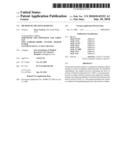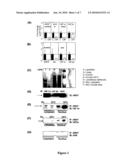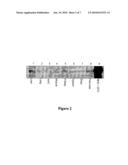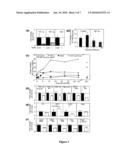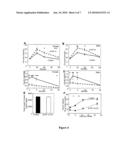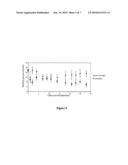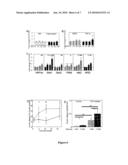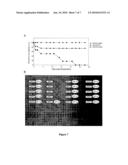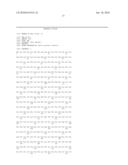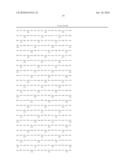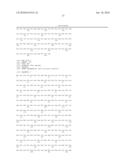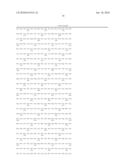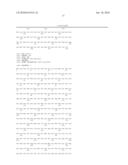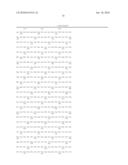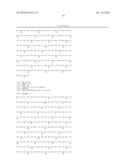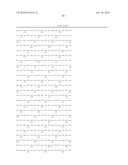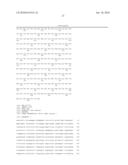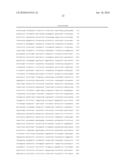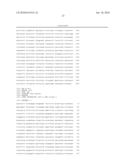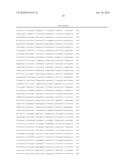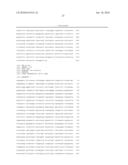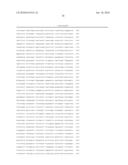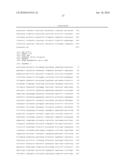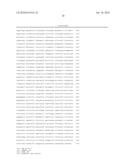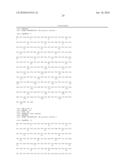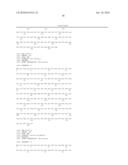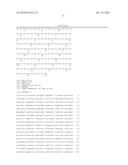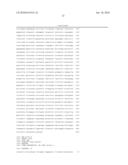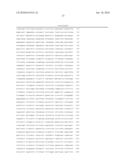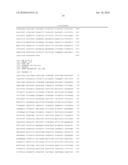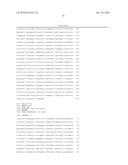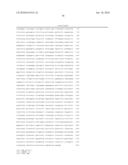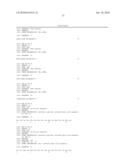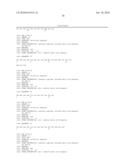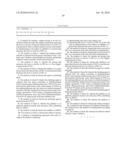Patent application title: METHOD OF TREATING DIABETES
Inventors:
Jenny Gunton (New South Wales, AU)
Assignees:
Garvan Institute of Medical Research C/-St. Vincent's Hospital
IPC8 Class: AA61K39395FI
USPC Class:
4241301
Class name: Drug, bio-affecting and body treating compositions immunoglobulin, antiserum, antibody, or antibody fragment, except conjugate or complex of the same with nonimmunoglobulin material
Publication date: 2010-06-10
Patent application number: 20100143333
Claims:
1. A method for treating a subject having or at risk of a diabetes-related
disorder, the method comprising increasing the level or activity of
Hypoxia Induced Factor 1.alpha. (HIF-1.alpha.) in pancreatic β-cells
or insulin-sensitive tissues in the subject by administering to the
subject an inhibitor of a protein that decreases the level or activity of
HIF-1.alpha..
2. The method of claim 1, wherein the diabetes-related disorder is selected from the group consisting of type 1 diabetes, type 2 diabetes, impaired glucose tolerance, gestational diabetes, insulin resistance and β-cell dysfunction.
3. The method of claim 1, wherein the protein that decreases the level or activity of HIF-1.alpha. is a Von Hippel-Lindau protein (VHL).
4. The method of claim 1, wherein the inhibitor is an agent that promotes the dissociation of HIF-1.alpha. and the protein that decreases the level or activity of HIF-1.alpha..
5. The method of claim 4, wherein the agent is a chelating agent.
6. The method of claim 5, wherein the chelating agent is selected from the group consisting of desferrioxamine (DFO), ferrioxamine, trihydroxamic acid, CP94, EDTA, desferrioxamine hydroxamic acids, deferoxamine B (DFO) as the methanesulfonate salt, also known as desferrioxamine B mesylate (DFOM), desferal from Novartis (previously Ciba-Giegy), apoferritin, CDTA (trans-1,2-diaminocyclohexane-N,N,N',N'-tetraacetic acid), and DTPA (diethylenetriamine-N,N,N',N'',N''-penta-acetic acid) and cobaltous ions.
7. The method of claim 6, wherein the chelating agent is desferrioxamine (DFO).
8. The method of claim 1, wherein the inhibitor is an antibody, antisense nucleic acid, ribozyme, PNA, interfering RNA or siRNA.
9. The method of claim 8, wherein the inhibitor is siRNA.
10. The method of claim 1, wherein the subject is human.
11. A method of transplanting pancreatic islet cells in a subject, the method comprising:(i) administering islet cells to the subject; and(ii) increasing the level or activity of HIF-1.alpha. in the islet cells by administering to the subject an inhibitor of a protein that decreases the level or activity of HIF-1.alpha..
12. The method of claim 11, wherein the level or activity of HIF-1.alpha. is increased in the islet cells before transplantation.
13. The method of claim 11, wherein the level or activity of HIF-1.alpha. is increased in the islet cells after transplantation.
14. The method of claim 11, wherein the protein that decreases the level or activity of HIF-1.alpha. is a Von Hippel-Lindau protein (VHL).
15. The method of claim 11, wherein the inhibitor is an agent that promotes the dissociation of HIF-1.alpha. and the protein that decreases the level or activity of HIF-1.alpha..
16. The method of claim 15, wherein the agent is a chelating agent.
17. The method of claim 16, wherein the chelating agent is selected from the group consisting of desferrioxamine (DFO), ferrioxamine, trihydroxamic acid, CP94, EDTA, desferrioxamine hydroxamic acids, deferoxamine B (DFO) as the methanesulfonate salt, also known as desferrioxamine B mesylate (DFOM), desferal from Novartis (previously Ciba-Giegy), apoferritin, CDTA (trans-1,2-diaminocyclohexane-N,N,N', N'tetraaceticacid), and DTPA (diethylenetriamine-N,N,N',N'',N''-penta-acetic acid) and cobaltous ions.
18. The method of claim 17, wherein the chelating agent is desferrioxamine (DFO).
19. The method of claim 11, wherein the inhibitor is an antibody, antisense nucleic acid, ribozyme, PNA, interfering RNA or siRNA.
20. The method of claim 19, wherein the inhibitor is siRNA.
21. The method of claim 11, wherein the subject is human.
22. A method for the treatment of a diabetes-related disorder, which involves the method of transplantation according to claim 11.
23. The method of claim 22, wherein the diabetes-related disorder is type 1 diabetes.
Description:
FIELD OF THE INVENTION
[0001]The present invention provides a method for treating a subject having or at risk of a diabetes-related disorder. The present invention also provides a method of transplanting pancreatic islet cells in a subject.
BACKGROUND OF THE INVENTION
[0002]Diabetes involves dysfunction of the pancreatic islet cells. In the case of type 1 diabetes, also referred to as insulin dependent diabetes mellitus (IDDM), dysfunction is initiated in the event of an immunological challenge. In the case of type 2 diabetes, also referred to as non-insulin dependent diabetes mellitus (NIDDM), islet dysfunction occurs upon exposure to a homeostatic challenge. Diabetes is associated with total β-cell mass, as well as the properties of individual β-cells.
[0003]Type 1 Diabetes and Insulitis. Type 1 diabetes is a chronic autoimmune disease in which insulin-producing cells (β-cells) within the pancreatic islets of Langerhans are selectively targeted and destroyed by an infiltrate of immunological cells. This infiltrate causes an inflammatory affect on the islets, known as insulitis.
[0004]The development of type 1 diabetes is associated with an initial genetic susceptibility, although this susceptibility is insufficient for development of the disease. In susceptible individuals, it has been hypothesized that a triggering event leads to an active autoimmunity attack against β-cells, resulting in insulitis, islet β-cell dysfunction, diminished insulin secretion, and ultimately, β-cell destruction. β-cells comprise the majority of pancreatic islet cells. Overt type 1 diabetes onset characterised by hyperglycemia may not be diagnosed until years after an initial triggering event, at which point most of the pancreatic β-cells are destroyed. When overt diabetes is first recognised, some residual insulin production remains, as demonstrated by the presence of the connecting peptide (C peptide) of proinsulin in the serum. However, the individual usually requires injections of exogenous insulin. Complete β-cell destruction is determined when C peptide can no longer be detected in the circulation after stimulation with glucose or arginine.
[0005]The initiating factor(s) and specific sequence of events leading to type 1 diabetes, including the relative importance of different cell types and cytokines, are still widely debated. It is generally accepted that insulitis leading to type 1 diabetes involves cellular migration and infiltration of T lymphocytes, macrophages, and dendritic cells within the pancreatic islets. Immune stimulation of the newly infiltrated cells, and cytokine-regulated effects of such infiltration result in inflammation and β-cell destruction (Mandrup-Poulsen, 1996). Interleukin 1β (IL 1β), alone or in combination with tumor necrosis factor α (TNFα) and interferon γ (IFN γ), exhibits cytotoxicity toward β-cells in vitro (Cetkovic et al., 1994). This cytotoxicity is partly mediated through induction of free radicals such as nitric oxide (NO), the production of which is catalysed by inducible nitric oxide synthase (iNOS). NO released in β-cells leads to nuclear DNA fragmentation and apoptosis, a result which can be partially prevented by iNOS blockers. However, the blockers may not be used in vivo because of the various roles of NO in other organ systems.
[0006]Conventional treatment protocols for type 1 diabetes comprise regular administration, of insulin. Preferably, the insulin is administerered by injection. Other protocols have been suggested which include such immunomodulatory and immunosuppressive agents as levamisol, theophyllin, thymic hormones, ciamexone, antithymocyte globulin, interferon, cyclosporin, nicotinamide, gamma globulin infusion, plasmapheresis or white cell transfusion. Although these protocols may delay onset of type 1 diabetes, some undesirable side effects are observed. Treatment protocols after onset of type 1 diabetes are particularly problematic, since by the time diabetes is diagnosed in humans, insulitis has already progressed dramatically, resulting in a β-cell loss of more than 80%. Islet cell transplantation is a viable treatment for type 1 diabetes although graft rejection is still a major problem. Survival of transplanted islets requires effective immunosuppression, to block the immune response that leads to graft rejection. However, it is thought that the majority of islet death occurs in the first week post-transplant with up to 70% of β-cells also undergoing apoptotic cell death triggered by nonimmunological factors, such as hypoxia.
[0007]Type 2 Diabetes. Type 2 diabetes often occurs in the face of normal, or even elevated levels of insulin. The condition appears to arise from β-cell dysfunction, usually combined with impaired ability of tissues to respond appropriately to insulin (i.e. insulin resistance), which challenges the homeostasis of blood glucose. Over time, many individuals with type 2 diabetes show decreased insulin production and require supplemental insulin to maintain blood glucose control, especially during times of stress or illness.
[0008]Conventional treatments for type 2 diabetes have not changed substantially in many years, and have significant limitations. While physical exercise and a reduction in caloric intake can improve the condition, compliance with such regimens is generally poor. Oral anti-diabetic drugs--the sulfonylureas, biguanides (metformin), thiazolidediones, α-glucosidase inhibitors (acarbose, miglitol), meglitinides (nateglinide, repaglinide) and exenatide can also be used to maintain blood glucose levels. Insulin therapy may also be used as an adjunct or alternative to oral medication therapy.
SUMMARY OF THE INVENTION
[0009]The present inventors have now made the surprising finding that the transcription factor hypoxia induced factor (HIF)-1α is needed for normal β-cell function, that is, glucose stimulated insulin secretion. In addition, the present inventors have also shown that inducing HIF-1α in islet cells prior to transplantation improved graft survival.
[0010]Accordingly, the present invention provides a method for treating a subject having or at risk of a diabetes-related disorder, the method comprising increasing the level or stability of HIF-1α activity in pancreatic β-cells or insulin-sensitive tissues in the subject.
[0011]In one embodiment of the invention, the diabetes-related disorder is selected from the group consisting of insulitis, type 1 diabetes, type 2 diabetes, impaired glucose tolerance, gestational diabetes, insulin resistance and β-cell dysfunction.
[0012]In a further preferred embodiment of the invention, the level or stability of HIF-1α activity is increased by administering to the subject an inhibitor of a protein that mediates degradation of HIF-1α.
[0013]In one embodiment of the invention, the protein that mediates degradation of HIF-1α is a Von Hippel-Lindau protein (VHL).
[0014]In a further preferred embodiment, the inhibitor of a protein that mediates degradation of HIF-1α is an antisense nucleic acid, ribozyme, PNA, interfering RNA, siRNA, microRNA or antibody. Preferably, the inhibitor is a siRNA.
[0015]In a further preferred embodiment of the invention, the level or stability of HIF-1α activity is increased by administering to the subject a chelating agent. Preferably, the chelating agent is an iron chelator.
[0016]The iron chelator is preferably selected from the group consisting of desferrioxamine (DFO), ferrioxamine, trihydroxamic acid, CP94, EDTA, desferrioxamine hydroxamic acids, deferoxamine B (DFO) as the methanesulfonate salt, also known as desferrioxamine B mesylate (DFOM), desferal from Novartis (previously Ciba-Giegy), apoferritin, CDTA (trans-1,2-diaminocyclohexane-N,N,N',N'-tetraacetic acid), and DTPA (diethylenetriamine-N,N,N',N'',N''-penta-acetic acid) and cobaltous ions.
[0017]In a preferred embodiment, the iron chelator is desferrioxamine (DFO).
[0018]In another embodiment of the invention, the level of HIF-1α is increased by administering to the subject a HIF-1α polypeptide or an active fragment thereof, or a polynucleotide encoding HIF-1α polypeptide or an active fragment thereof.
[0019]In a one embodiment of the invention, the polynucleotide is a vector encoding a HIF-1α polypeptide or active fragment thereof. Preferably the vector is a viral vector.
[0020]In a further preferred embodiment of the invention, the vector is within a cell. Preferably, the cell is a pancreatic n-cell. More preferably the cell is autologous.
[0021]In a further preferred embodiment of the invention, the HIF-1α polypeptide or active fragment thereof is administered with a pharmaceutically acceptable carrier.
[0022]The present invention also provides a method of transplanting pancreatic islet cells in a subject, the method comprising administering islet cells to a subject and increasing the level or activity of HIF-1α in the islet cells.
[0023]In one embodiment of the invention, the level or stability of HIF-1α in increased in the islet cells before transplantation.
[0024]In another embodiment of the invention, the level or stability of HIF-1α is increased in the islet cells after transplantation.
[0025]In a further preferred embodiment of the invention, the level or stability of HIF-1α activity is increased by administering to the subject an inhibitor of a protein that mediates degradation of HIF-1α.
[0026]In one embodiment of the invention, the protein that mediates degradation of HIF-1α is VHL.
[0027]In a further preferred embodiment of the invention, the inhibitor of a protein that mediates degradation of HIF-1α is an antisense nucleic acid, ribozyme, PNA, interfering RNA, siRNA, microRNA or antibody. Preferably, the inhibitor is a siRNA.
[0028]In a further preferred embodiment of the invention, the level or stability of HIF-1α activity is increased by administering to the subject an iron chelator.
[0029]The iron chelator is preferably selected from the group consisting of desferrioxamine (DFO), ferrioxamine, trihydroxamic acid, CP94, EDTA, desferrioxamine hydroxamic acids, deferoxamine B (DFO) as the methanesulfonate salt, also known as desferrioxamine B mesylate (DFOM), desferal from Novartis (previously Ciba-Giegy), apoferritin, CDTA (trans-1,2-diaminocyclohexane-N,N,N',N'-tetraacetic acid), and DTPA (diethylenetriamine-N,N,N',N'',N''-penta-acetic acid) and cobaltous ions.
[0030]In a preferred embodiment, the iron chelator is desferrioxamine (DFO).
[0031]In another embodiment of the invention the level of HIF-1α is increased by administering to the subject a HIF-1α polypeptide or an active fragment thereof, or a polynucleotide encoding HIF-1α polypeptide or an active fragment thereof.
[0032]In a one embodiment of the invention, the polynucleotide is a vector encoding a HIF-1α polypeptide or active fragment thereof. Preferably the vector is a viral vector.
[0033]In a further preferred embodiment of the invention, the vector is within a cell. Preferably, the cell is a pancreatic β-cell. More preferably the cell is autologous.
[0034]In a further preferred embodiment of the invention, the HIF-1α polypeptide or active fragment thereof is administered with a pharmaceutically acceptable carrier.
[0035]The present invention also provides a method for the treatment of a diabetes-related disorder, which involves the method of transplantation according to the methods of the invention. Preferably, the diabetes-related disorder is type 1 diabetes.
[0036]The methods of the invention can be performed on a range of different subjects. Preferably, the subject is a mammal. More preferably, the subject is human.
[0037]Throughout this specification the word "comprise", or variations such as "comprises" or "comprising", will be understood to imply the inclusion of a stated element, integer or step, or group of elements, integers or steps, but not the exclusion of any other element, integer or step, or group of elements, integers or steps.
[0038]As will be apparent, preferred features and characteristics of one aspect of the invention are applicable to other aspects of the invention.
[0039]The invention is hereinafter described by way of the following non-limiting Examples and with reference to the accompanying figures.
BRIEF DESCRIPTION OF THE ACCOMPANYING DRAWINGS
[0040]FIG. 1: HIF-1α is present in human and mouse islets and in Min6 cells, and is decreased in islets from people with diabetes. (A) By real-time PCR, expression of ARNT and HIF-1α were decreased by 90% in islets from people with type 2 diabetes (white bars) compared to control subjects (black bars). Expression of AhR was also decreased. (B) In islets isolated from mice with β-cell specific knockout of ARNT, HIF-1α expression was significantly decreased. (C) Following ARNT affinity-purification, a band corresponding to HIF-1α was present in Min6 cells basally and following treatment with DFO. (D) ARNT co-immunoprecipitated with HIF-1α, HIF-2α and AhR in Min6 cells. (E) HIF-1α co-immunoprecipitated with ARNT, both in the basal state and following treatment with DFO. (F) HIF-2α also co-immunoprecipitated with ARNT. (G) AhR did not co-immunoprecipitate with ARNT.
[0041]FIG. 2: HIF-1αprotein is present in a range of normal tissues, and in Min6 cells. Tissues were isolated from wild-type mice and immediately snap-frozen in liquid nitrogen. HIF-1α protein was detectable following immunoprecipitation in liver, muscle, kidney, pancreas and in Min6 cells, used as the positive control.
[0042]FIG. 3: Knockdown of HIF-1α protein markedly impairs glucose stimulated ATP generation, glucose stimulated insulin secretion and gene expression in Min6 cells. (A) RNAi treatment for 48 hours produced significant decreases in expression of HIF-1α, HIF-2α and AhR (p<0.01, 0.01 and 0.05 respectively). (B) In control cells, increasing glucose concentration from 1 mM to 25 mM caused a significant increase in cellular ATP concentration (p<0.05) but this was completely blocked in cells treated with RNAi directed against HIF-1α. (C) Min6 cells treated with scrambled control RNAi sequences have normal glucose stimulated insulin secretion (GSIS). Treatment with HIF-1α RNAi severely impaired GSIS, similar to that seen with ARNT RNAi. Addition of HIF-2α or HIF-2α+AhR RNAis did not cause significant further decreases in GSIS. HIF-2α RNAi alone or AhR RNAi alone produced ˜25% impairment in GSIS (data not shown). (D) HIF-1α RNAi caused significant decreases in gene expression in Min6 cells with decreased expression of the MODY genes HNF1α, PDX-1 and glucokinase (GK) and a trend to decreased HNF4α. (E) Expression of IRS-2 was significantly decreased by HIF-1α RNAi and (F) Expression of GLUT1, G6PI, aldolase (Aldo) and phosphofructokinase (PFK) mRNAs were all significantly decreased by HIF-1α RNAi.
[0043]FIG. 4: Glucose tolerance is abnormal in β-HIF-1α mice. (A) Female β-HIF-1α mice have marked glucose intolerance following intraperitoneal glucose tolerance testing (2 g/kg). (B) Male β-HIF-1α mice also have significantly worse glucose intolerance. The glucose intolerance due to a β-cell defect, demonstrated by severely impaired GSIS in both female (C) and male (D) β-HIF-1α mice. (E) Total insulin content was unchanged in islets isolated from β-HIF-1α mice compared to their controls. Despite this, the islets in vitro show marked impairment in GSIS, shown in (F).
[0044]FIG. 5: Islets from β-HIF-1α mice were unable to control glucose post-transplantation. Islets were isolated from mice and transplanted into diabetic SCID mice in a 1 donor: 1 recipient ratio. Despite similar numbers of islets being isolated from β-HIF-1α and control mice, and identical total insulin content, islets from β-HIF-1α mice were unable to control glucose.
[0045]FIG. 6: Increasing HIF-1α protein by treatment with DFO at the concentrations shown for 4 hours markedly improves II-cell function. (A) DFO treatment did not alter expression of the house-keeping genes TATA-box binding protein (TBP) or transthyretin, or (B) increase expression of ARNT. However, at the highest dose, mRNA for HIF-1α showed increased expression. (C) DFO treatment significantly increased expression of several genes known to be important for normal β-cell function including HNF4α, GLUT1, GLUT2, phosphoglucomutase (PGM), IRS-2 and Akt2 (D) Human islets cells treated with DFO for 4 hours showed markedly improved GSIS. (E) In accord with the increased insulin release, DFO treatment was associated with increased ATP concentrations (E). Black lines indicate which columns/groups are being compared for the significance levels.
[0046]FIG. 7: DFO treatment improves outcome of minimal-mass human islet transplantation in mice. (A) Human islets from 3 different donors were transplanted into diabetic SCID mice either in an excess number (2000 IEQ per mouse), or in a minimal mass number (600 IEQ per mouse). The minimal mass islets were treated with control or DFO at 125 μmol/L for 2 hours prior to transplantation. As shown, large numbers of islets from each preparation were able to reverse diabetes in all recipients (n=3). As expected, 600 IEQ isolated from the same people cured diabetes in 0% (n=6). In contrast, 2 hours of culture with DFO improved outcome following transplantation of 600 IEQ to 75% (n=8). (B) Model of HIF-1α function in β-cells. DFO treatment increases HIF-1α by inhibiting its degradation, and has marked beneficial effects on β-cell function. Under normoxic conditions, HIF-1α is required for normal β-cell function, as loss by RNAi in cell culture or deletion in mice impairs GSIS. The pancreas is normally exposed to relative hypoxia (5-8% O2), and under these conditions, HIF-1α is particularly important for survival and maintenance of β-cell function. In the setting of anoxia, HIF-1α is not able to prevent β-cell demise.
KEY TO SEQUENCE LISTING
[0047]SEQ ID NO: 1=Homo sapiens HIF-1α protein isoform 1 [accession no. NP--001521]SEQ ID NO: 2=Homo sapiens HIF-1α protein isoform 2 [accession no. NP--851397]SEQ ID NO: 3=Mus musculus HIF-1α protein [accession no. NP--034561]SEQ ID NO: 4=Rattus norvegicus HIF-1α protein [accession no. NP--077335]SEQ ID NO: 5=Homo sapiens HIF-1α cDNA variant 1 [accession no. NM--001530]SEQ ID NO: 6=Homo sapiens HIF-1α cDNA variant 2 [accession no. NM--181054]SEQ ID NO: 7=Mus musculus HIF-1α cDNA [accession no. NM--010431]SEQ ID NO: 8=Rattus norvegicus HIF-1α cDNA [accession no. NM--024359]SEQ ID NO: 9=Homo sapiens VHL protein isoform 1 [accession no. NP--000542]SEQ ID NO: 10=Homo sapiens VHL protein isoform 2 [accession no. NP--937799]SEQ ID NO: 11=Mus musculus VHL protein [accession no. NP--033533]SEQ ID NO: 12=Rattus norvegicus VHL protein [accession no. NP--434688]SEQ ID NO: 13=Homo sapiens VHL cDNA variant 1 [accession no. NM--000551]SEQ ID NO: 14=Homo sapiens VHL cDNA variant 2 [accession no. NM--198156]SEQ ID NO: 15=Mus musculus VHL cDNA [accession no. NM--009507]SEQ ID NO: 16=Rattus norvegicus VHL cDNA [accession no. NM--052801]SEQ ID NO: 17=VHL siRNASEQ ID NO: 18=VHL siRNASEQ ID NO: 19=VHL siRNASEQ ID NO: 20=VHL siRNASEQ ID NO: 21=Identified peptide (matched amino acid sequence for HIF-1α)SEQ ID NO: 22=Identified peptide (matched amino acid sequence for HIF-1α)SEQ ID NO: 23=Identified peptide (matched amino acid sequence for HIF-1α)SEQ ID NO: 24=Identified peptide (matched amino acid sequence for HIF-1α)SEQ ID NO: 25=Identified peptide (matched amino acid sequence for HIF-2α)SEQ ID NO: 26=Identified peptide (matched amino acid sequence for HIF-2α)
DETAILED DESCRIPTION OF THE PREFERRED EMBODIMENTS
General Techniques
[0048]Unless specifically defined otherwise, all technical and scientific terms used herein shall be taken to have the same meaning as commonly understood by one of ordinary skill in the art (for example, in cell culture, molecular genetics, immunology, immunohistochemistry, protein chemistry, and biochemistry).
[0049]Unless otherwise indicated, the recombinant protein, cell culture, and immunological techniques utilised in the present invention are standard procedures, well known to those skilled in the art. Such techniques are described and explained throughout the literature in sources such as, J. Perbal, A Practical Guide to Molecular Cloning, John Wiley and Sons (1984), J. Sambrook et al., Molecular Cloning: A Laboratory Manual, Cold Spring Harbour Laboratory Press (1989), T. A. Brown (editor), Essential Molecular Biology: A Practical Approach, Volumes 1 and 2, IRL Press (1991), D. M. Glover and B. D. Hames (editors), DNA Cloning: A Practical Approach, Volumes 1-4, IRL Press (1995 and 1996), and F. M. Ausubel et al. (editors), Current Protocols in Molecular Biology, Greene Pub. Associates and Wiley-Interscience (1988, including all updates until present), Ed Harlow and David Lane (editors) Antibodies: A Laboratory Manual, Cold Spring Harbour Laboratory, (1988), and J. E. Coligan et al. (editors) Current Protocols in Immunology, John Wiley & Sons (including all updates until present).
Diabetes-Related Disorders
[0050]The present invention provides a method for treating a subject having or at risk of a diabetes-related disorder.
[0051]By "treating", it is meant to ameliorate, inhibit, lessen, reverse, or prevent a diabetes-related disorder, or to delay onset of a diabetes-related disorder.
[0052]By "diabetes-related disorder" it is meant to include diabetes and any manifested symptoms of diabetes in any mammal, such as impaired glucose tolerance, gestational diabetes, insulin resistance, β-cell dysfunction, insulitis. Human forms include type 1 and type 2 diabetes, gestational diabetes and rare monogenic forms such as the maturity onset diabetes of the young syndromes.
[0053]By "at risk of" it is meant a subject not formally diagnosed with diabetes, but demonstrating a symptom in terms of insulin or glucose level, and susceptibility to diabetes or a related condition due to family history, genetic predisposition, or obesity in the case of type 2 diabetes, or has previously had diabetes or a related condition and is subject to risk of recurrence.
HIF-1α Polypeptides and Polynucleotides
[0054]As used herein "HIF-1" is characterised as a DNA-binding protein which binds to a region in the regulatory, preferably in the enhancer region, of a structural gene having the HIF-1 binding motif. Included among the structural genes which can be activated by HIF-1 are erythropoietin (EPO), vascular endothelial growth factor (VEGF), and glycolytic gene transcription in cells subjected to hypoxia.
[0055]HIF-1 is composed of subunits HIF-1α and an isoform of HIF-1β. In addition to having domains which allow for their mutual association in forming HIF-1, the α and β subunits of HIF-1 both contain DNA-binding domains. The α subunit is uniquely present in HIF-1, whereas the β subunit (ARNT) is a component of at least two other transcription factors.
[0056]The methods of the present invention involve increasing the level or stability of HIF-1α in pancreatic β-cells or insulin-sensitive tissues of the subject.
[0057]By "insulin-sensitive tissues" it is meant tissues that are responsive to insulin action (including the uptake of glucose) at a clinically-normal level.
[0058]In one embodiment, the methods of the invention involve administering to the subject a HIF-1α polypeptide or an active fragment thereof, or a polynucleotide encoding HIF-1α polypeptide or an active fragment thereof.
[0059]The HIF-1α polypeptide can be a substantially purified, or recombinant polypeptide. Preferably, the HIF-1α polypeptide comprises a sequence which shares at least 75% identity with a sequence as shown in any one of SEQ ID NOS: 1 to 4.
[0060]By "substantially purified polypeptide" or "purified" we mean a polypeptide that has been separated from one or more lipids, nucleic acids, other polypeptides, or other contaminating molecules with which it is associated in its native state. It is preferred that the substantially purified polypeptide is at least 60% free, more preferably at least 75% free, and more preferably at least 90% free from other components with which it is naturally associated.
[0061]The term "recombinant" in the context of a polypeptide refers to the polypeptide when produced by a cell, or in a cell-free expression system, in an altered amount or at an altered rate compared to its native state. In one embodiment, the cell is a cell that does not naturally produce the polypeptide. However, the cell may be a cell which comprises a non-endogenous gene that causes an altered, preferably increased, amount of the polypeptide to be produced. A recombinant polypeptide of the invention includes polypeptides which have not been separated from other components of the transgenic (recombinant) cell, or cell-free expression system, in which it is produced, and polypeptides produced in such cells or cell-free systems which are subsequently purified away from at least some other components.
[0062]The terms "polypeptide" and "protein" are generally used interchangeably and refer to a single polypeptide chain which may or may not be modified by addition of non-amino acid groups. It would be understood that such polypeptide chains may associate with other polypeptides or proteins or other molecules such as co-factors. The terms "proteins" and "polypeptides" as used herein also include variants, mutants, modifications, analogous and/or derivatives of the polypeptides of the invention as described herein.
[0063]The % identity of a polypeptide is determined by GAP (Needleman and Wunsch, 1970) analysis (GCG program) with a gap creation penalty=5, and a gap extension penalty=0.3. The query sequence is at least 25 amino acids in length, and the GAP analysis aligns the two sequences over a region of at least 25 amino acids. More preferably, the query sequence is at least 50 amino acids in length, and the GAP analysis aligns the two sequences over a region of at least 50 amino acids. More preferably, the query sequence is at least 100 amino acids in length and the GAP analysis aligns the two sequences over a region of at least 100 amino acids. Even more preferably, the query sequence is at least 250 amino acids in length and the GAP analysis aligns the two sequences over a region of at least 250 amino acids. Even more preferably, the GAP analysis aligns the two sequences over their entire length.
[0064]As used herein a "biologically active fragment" is a portion of a polypeptide of the invention which maintains a defined activity of the full-length polypeptide, namely be able to promote glucose stimulated insulin secretion (GSIS) and cell survival. In one embodiment, the biologically active fragment contains one and preferably both of the transactivation domains of HIF-1α. By "transactivation domains of HIF-1α" it is meant the NH2-terminal transactivation domain (amino acids 531-575) and the COOH-terminal transactivation domain (amino acids 786-826) of HIF-1α that interact with general transcription machinery to activate transcription from promoters of HIF-1α. target genes. Biologically active fragments can be any size as long as they maintain the defined activity. Preferably, biologically active fragments are at least 100, more preferably at least 200, and even more preferably at least 350 amino acids in length.
[0065]With regard to a defined polypeptide, it will be appreciated that % identity figures higher than those provided above will encompass preferred embodiments. Thus, where applicable, in light of the minimum % identity figures, it is preferred that the polypeptide comprises an amino acid sequence which is at least 75%, more preferably at least 80%, more preferably at least 85%, more preferably at least 90%, more preferably at least 91%, more preferably at least 92%, more preferably at least 93%, more preferably at least 94%, more preferably at least 95%, more preferably at least 96%, more preferably at least 97%, more preferably at least 98%, more preferably at least 99% identical to the relevant nominated SEQ ID NO.
[0066]Amino acid sequence mutants of the polypeptides of the present invention can be prepared by introducing appropriate nucleotide changes into a nucleic acid of the present invention, or by in vitro synthesis of the desired polypeptide. Such mutants include, for example, deletions, insertions or substitutions of residues within the amino acid sequence. A combination of deletion, insertion and substitution can be made to arrive at the final construct, provided that the final polypeptide product possesses the desired characteristics.
[0067]Mutant (altered) polypeptides can be prepared using any technique known in the art. For example, a polynucleotide of the invention can be subjected to in vitro mutagenesis. Such in vitro mutagenesis techniques may include sub-cloning the polynucleotide into a suitable vector, transforming the vector into a "mutator" strain such as the E. coli XL-1 red (Stratagene) and propagating the transformed bacteria for a suitable number of generations. In another example, the polynucleotides of the invention are subjected to DNA shuffling techniques as broadly described by Harayama (1998). Products derived from mutated/altered DNA can readily be screened using techniques described herein to determine if they are able to confer enhanced GSIS, and/or improved islet graft survival.
[0068]In designing amino acid sequence mutants, the location of the mutation site and the nature of the mutation will depend on characteristic(s) to be modified. The sites for mutation can be modified individually or in series, for example, by (1) substituting first with conservative amino acid choices and then with more radical selections depending upon the results achieved, (2) deleting the target residue, or (3) inserting other residues adjacent to the located site.
[0069]Amino acid sequence deletions generally range from about 1 to 15 residues, more preferably about 1 to 10 residues and typically about 1 to 5 contiguous residues.
[0070]Substitution mutants have at least one amino acid residue in the polypeptide molecule removed and a different residue inserted in its place. The sites of greatest interest for substitutional mutagenesis include sites identified as important for function. Other sites of interest are those in which particular residues obtained from various strains or species are identical. These positions may be important for biological activity. These sites, especially those falling within a sequence of at least three other identically conserved sites, are preferably substituted in a relatively conservative manner. Such conservative substitutions are shown in Table 1 under the heading of "exemplary substitutions".
[0071]Furthermore, if desired, unnatural amino acids or chemical amino acid analogues can be introduced as a substitution or addition into the polypeptides of the present invention. Such amino acids include, but are not limited to, the D-isomers of the common amino acids, 2,4-diaminobutyric acid, α-amino isobutyric acid, 4-aminobutyric acid, 2-aminobutyric acid, 6-amino hexanoic acid, 2-amino isobutyric acid, 3-amino propionic acid, ornithine, norleucine, norvaline, hydroxyproline, sarcosine, citrulline, homocitrulline, cysteic acid, t-butylglycine, t-butylalanine, phenylglycine, cyclohexylalanine, β-alanine, fluoro-amino acids, designer amino acids such as β-methyl amino acids, Cα-methyl amino acids, Nα-methyl amino acids, and amino acid analogues in general.
[0072]Also included within the scope of the invention are polypeptides of the present invention which are differentially modified during or after synthesis, for example, by biotinylation, benzylation, glycosylation, acetylation, phosphorylation, amidation, derivatization by known protecting/blocking groups, proteolytic cleavage, linkage to an antibody molecule or other cellular ligand, etc. These modifications may serve to increase the stability and/or bioactivity of the polypeptide of the invention.
TABLE-US-00001 TABLE 1 Exemplary substitutions Original Exemplary Residue Substitutions Ala (A) val; leu; ile; gly Arg (R) lys Asn (N) gln; his Asp (D) glu Cys (C) ser Gln (Q) asn; his Glu (E) asp Gly (G) pro, ala His (H) asn; gln Ile (I) leu; val; ala Leu (L) ile; val; met; ala; phe Lys (K) arg Met (M) leu; phe Phe (F) leu; val; ala Pro (P) gly Ser (S) thr Thr (T) ser Trp (W) tyr Tyr (Y) trp; phe Val (V) ile; leu; met; phe; ala
Polypeptides of the present invention can be produced in a variety of ways, including production and recovery of natural polypeptides, production and recovery of recombinant polypeptides, and chemical synthesis of the polypeptides. In one embodiment, an isolated polypeptide of the present invention is produced by culturing a cell capable of expressing the polypeptide under conditions effective to produce the polypeptide, and recovering the polypeptide. Effective culture conditions include, but are not limited to, effective media, bioreactor, temperature, pH and oxygen conditions that permit polypeptide production. An effective medium refers to any medium in which a cell is cultured to produce a polypeptide of the present invention. Such medium typically comprises an aqueous medium having assimilable carbon, nitrogen and phosphate sources, and appropriate salts, minerals, metals and other nutrients, such as vitamins. Cells can be cultured in conventional fermentation bioreactors, shake flasks, test tubes, microtiter dishes, and petri plates. Culturing can be carried out at a temperature, pH and oxygen content appropriate for a recombinant cell. Such culturing conditions are within the expertise of one of ordinary skill in the art.
[0073]In another embodiment, the methods of the invention involve administration of a polynucleotide encoding HIF-1α or an active fragment thereof. The HIF-1α polynucleotide can be an isolated or exogenous polynucleotide. Preferably, the HIF-1α polynucleotide comprises a sequence which shares at least 75% identity with a sequence as shown in any one of SEQ ID NOS: 5 to 8.
[0074]By an "isolated polynucleotide", including DNA, RNA, or a combination of these, single or double stranded, in the sense or antisense orientation or a combination of both, dsRNA or otherwise, we mean a polynucleotide which is at least partially separated from the polynucleotide sequences with which it is associated or linked in its native state. Preferably, the isolated polynucleotide is at least 60% free, preferably at least 75% free, and most preferably at least 90% free from other components with which they are naturally associated. Furthermore, the term "polynucleotide" is used interchangeably herein with the term "nucleic acid".
[0075]The term "exogenous" in the context of a polynucleotide refers to the polynucleotide when present in a cell, or in a cell-free expression system, in an altered amount compared to its native state. In one embodiment, the cell is a cell that does not naturally comprise the polynucleotide. However, the cell may be a cell which comprises a non-endogenous polynucleotide resulting in an altered, preferably increased, amount of production of the encoded polypeptide. An exogenous polynucleotide of the invention includes polynucleotides which have not been separated from other components of the transgenic (recombinant) cell, or cell-free expression system, in which it is present, and polynucleotides produced in such cells or cell-free systems which are subsequently purified away from at least some other components.
[0076]The % identity of a polynucleotide is determined by GAP (Needleman and Wunsch, 1970) analysis (GCG program) with a gap creation penalty=5, and a gap extension penalty=0.3. Unless stated otherwise, the query sequence is at least 45 nucleotides in length, and the GAP analysis aligns the two sequences over a region of at least 45 nucleotides. Preferably, the query sequence is at least 150 nucleotides in length, and the GAP analysis aligns the two sequences over a region of at least 150 nucleotides. More preferably, the query sequence is at least 300 nucleotides in length and the GAP analysis aligns the two sequences over a region of at least 300 nucleotides. Even more preferably, the GAP analysis aligns the two sequences over their entire length.
[0077]With regard to the defined polynucleotides, it will be appreciated that % identity figures higher than those provided above will encompass preferred embodiments. Thus, where applicable, in light of the minimum % identity figures, it is preferred that a polynucleotide of the invention comprises a sequence which is at least 75%, more preferably at least 80%, more preferably at least 85%, more preferably at least 90%, more preferably at least 91%, more preferably at least 92%, more preferably at least 93%, more preferably at least 94%, more preferably at least 95%, more preferably at least 96%, more preferably at least 97%, more preferably at least 98%, more preferably at least 99%, more preferably at least 99.1%, more preferably at least 99.2%, more preferably at least 99.3%, more preferably at least 99.4%, more preferably at least 99.5%, more preferably at least 99.6%, more preferably at least 99.7%, more preferably at least 99.8%, and even more preferably at least 99.9% identical to the relevant nominated SEQ ID NO.
[0078]Polynucleotides of the present invention may possess, when compared to naturally occurring molecules, one or more mutations which are deletions, insertions, or substitutions of nucleotide residues. Mutants can be either naturally occurring (that is to say, isolated from a natural source) or synthetic (for example, by performing site-directed mutagenesis on the nucleic acid).
Administration of HIF-1α Polypeptides and Polynucleotides
[0079]In a preferred embodiment of the invention, an HIF-1α polypeptide or active fragment thereof is administered with a biologically acceptable carrier.
[0080]The phrase, "biologically acceptable carrier" refers to any diluent, excipient, additive, or solvent which is either pharmaceutically accepted for use in the mammal for which a composition is formulated.
[0081]Routes of administration of the polypeptide or active fragment thereof include but are not limited to parenteral (for example, intravenous, intradermal, intraperitoneal or subcutaneous), oral, inhalational (for example, intranasal), transdermal (for example, topical), transmucosal, and rectal administration.
[0082]In a further preferred embodiment of the invention, the HIF-1α polynucleotide is inserted into a recombinant expression vector for the purposes of administration to the subject.
[0083]The term "recombinant expression vector" refers to a plasmid, virus or other vehicle known in the art that has been manipulated by insertion or incorporation of the HIF-1α genetic sequences. Such expression vectors contain a promoter sequence which facilitates the efficient transcription in the host of the inserted genetic sequence. The expression vector typically contains an origin of replication, a promoter, as well as specific genes which allow phenotypic selection of the transformed cells.
[0084]In one embodiment, the viral vector is derived from adeno-associated virus (AAV) and comprises a constitutive or regulatable promoter capable of driving sufficient levels of expression of the HIF-1α-encoding DNA in the viral vector. Preferably, the viral vector comprises inverted terminal repeat sequences of AAV, such as those described in WO 93/24641. In a preferred embodiment, the viral vector comprises polynucleotide sequences of the pTR-UF5 plasmid. The pTR-UF5 plasmid is a modified version of the pTRBS-UF/UF1/UF2/UFB series of plasmids (Zolotukiin et al., 1996; Klein et al., 1998).
[0085]Promoters useful with the subject invention include, for example, the cytomegalovirus immediate early promoter (CMV), the human elongation factor 1-α promoter (EF1), the small nuclear RNA promoters (U1a and U1b), α-myosin heavy chain promoter, Simian virus 40 promoter (SV40), Rous sarcoma virus promoter (RSV), Adenovirus major late promoter, β-actin promoter and hybrid regulatory element comprising a CMV enhancer/β-actin promoter. These promoters have been shown to be active in a wide range of mammalian cells.
[0086]The promoters are operably linked with heterologous DNA encoding HIF-1α. By "operably linked", it is intended that the promoter element is positioned relative to the coding sequence to be capable of effecting expression of the coding sequence.
[0087]Promoters particularly useful for expression of a protein in islet cells include, for example the insulin promoter (for example, the rat insulin promoter) and the PDX1/IPF1 promoter.
[0088]Also contemplated for use with the vectors of the present invention are inducible and cell type specific promoters. For example, Tet-inducible promoters (Clontech, Palo Alto, Calif.) and VP16-LexA promoters (Nettelbeck et al., 1998) can be used in the present invention.
[0089]The vectors can also include introns inserted into the polynucleotide sequence of the vector as a means for increasing expression of heterologous DNA encoding HIF-1α. For example, an intron can be inserted between a promoter sequence and the region coding for the protein of interest on the vector. Introns can also be inserted in the coding regions. Transcriptional enhancer elements which can function to increase levels of transcription from a given promoter can also be included in the vectors of the invention. Enhancers can generally be placed in either orientation, 3' or 5', with respect to promoter sequences. In addition to the natural enhancers, synthetic enhancers can be used in the present invention. For example, a synthetic enhancer randomly assembled from Spc5-12-derived elements including muscle-specific elements, serum response factor binding element (SRE), myocyte-specific enhancer factor-1 (MEF-1), myocyte-specific enhancer factor-2 (MEF-2), transcription enhancer factor-1 (TEF-1) and SP-1 (Li et al., 1999; Deshpande et al., 1997; Stewart et al., 1996; Mitchell and Tjian, 1989; Briggs et al., 1986; Pitluk et al., 1991) can be used in vectors of the invention.
[0090]The gene therapy methods of the invention can be performed by ex vivo or in vivo treatment of the patient's cells or tissues, preferably the patient's islet cells or pancreatic tissue. The vectors of the invention can be introduced into suitable cells, cell lines or tissue using methods known in the art. The viral particles and vectors can be introduced into cells or tissue in vitro or in vivo. Methods contemplated include transfection, transduction, injection and inhalation. For example, vectors can be introduced into cells using liposomes containing the subject vectors, by direct transfection with vectors alone, electroporation or by particle bombardment. In an exemplified embodiment, islet cells are infected in vivo by injection of viral particles comprising recombinant vector into pancreatic tissue of the subject.
[0091]The dosage of recombinant vector or the virus to be administered to the subject can be determined by the ordinarily skilled clinician based on various parameters such as mode of administration, duration of treatment, the disease state or condition involved, and the like. Typically, recombinant virus of the invention is administered in doses between 105 and 1014 infectious units. The recombinant vectors and virus of the present invention can be prepared in formulations using methods and materials known in the art. Numerous formulations can be found in Remington's Pharmaceutical Sciences, 15th Edition (1975).
Inhibitors of Proteins that Mediate Degradation of HIF-1α
[0092]In one embodiment, the methods of the invention involve administering to the subject an inhibitor of a protein that mediates degradation of HIF-1α.
[0093]In a preferred embodiment, the protein that mediates degradation of HIF-1α is a Von Hippel-Lindau protein (VHL). Preferably, the VHL protein has a sequence which shares at least 75% identity with a sequence as shown in any one of SEQ ID NO: 9 to 12.
[0094]In a further preferred embodiment, the inhibitor of a protein that mediates degradation of HIF-1α is selected from the group consisting of an antisense polynucleotide, ribozyme, PNA, interfering RNA, siRNA, microRNA or antibody. These inhibitors are described in detail below. In a preferred embodiment, the inhibitor targets the portion of the VHL protein that binds to the oxygen degradation domain of HIF-1α.
Antisense Polynucleotides
[0095]The term "antisense polynucleotide" shall be taken to mean a DNA or RNA, or combination thereof, molecule that is complementary to at least a portion of a specific mRNA molecule encoding a polypeptide of the invention and capable of interfering with a post-transcriptional event such as mRNA translation. The use of antisense methods is well known in the art (see for example, G. Hartmann and S. Endres, Manual of Antisense Methodology, Kluwer (1999)).
[0096]An antisense polynucleotide of the invention will hybridise to a target polynucleotide under physiological conditions. As used herein, the term "an antisense polynucleotide which hybridises under physiological conditions" means that the polynucleotide (which is fully or partially single stranded) is at least capable of forming a double stranded polynucleotide with mRNA encoding a protein, such as those encoding the VHL protein (the corresponding cDNA sequence of which is provided in any one of SEQ ID NO:13 to 16) under normal conditions in a cell, preferably a β-cell.
[0097]Antisense molecules may include sequences that correspond to the structural genes or for sequences that effect control over the gene expression or splicing event. For example, the antisense sequence may correspond to the targeted coding region of the genes of the invention, or the 5'-untranslated region (UTR) or the 3'-UTR or combination of these. It may be complementary in part to intron sequences, which may be spliced out during or after transcription, preferably only to exon sequences of the target gene. In view of the generally greater divergence of the UTRs, targeting these regions provides greater specificity of gene inhibition.
[0098]The length of the antisense sequence should be at least 19 contiguous nucleotides, preferably at least 50 nucleotides, and more preferably at least 100, 200, 500 or 1000 nucleotides. The full-length sequence complementary to the entire gene transcript may be used. The length is most preferably 100-2000 nucleotides. The degree of identity of the antisense sequence to the targeted transcript should be at least 90% and more preferably 95-100%. The antisense RNA molecule may of course comprise unrelated sequences which may function to stabilise the molecule.
Catalytic Polynucleotides
[0099]The term "catalytic polynucleotide/nucleic acid" refers to a DNA molecule or DNA-containing molecule (also known in the art as a "deoxyribozyme") or an RNA or RNA-containing molecule (also known as a "ribozyme") which specifically recognises a distinct substrate and catalyses the chemical modification of this substrate. The nucleic acid bases in the catalytic nucleic acid can be bases A, C, G, T (and U for RNA). Typically, the catalytic nucleic acid contains an antisense sequence for specific recognition of a target nucleic acid, and a nucleic acid cleaving enzymatic activity (also referred to herein as the "catalytic domain"). The types of ribozymes that are particularly useful in this invention are the hammerhead ribozyme (Haseloff and Gerlach, 1988, Perriman et al. 1992) and the hairpin ribozyme (Zolotukiin et al., 1996; Klein et al., 1998; Shippy et al., 1999).
[0100]The ribozymes of this invention and DNA encoding the ribozymes can be chemically synthesised using methods well known in the art. The ribozymes can also be prepared from a DNA molecule (that upon transcription, yields an RNA molecule) operably linked to an RNA polymerase promoter, for example, the promoter for T7 RNA polymerase or SP6 RNA polymerase. Accordingly, also provided by this invention is a nucleic acid molecule, that is, DNA or cDNA, coding for a catalytic polynucleotide of the invention. When the vector also contains an RNA polymerase promoter operably linked to the DNA molecule, the ribozyme can be produced in vitro upon incubation with RNA polymerase and nucleotides. In a separate embodiment, the DNA can be inserted into an expression cassette or transcription cassette. After synthesis, the RNA molecule can be modified by ligation to a DNA molecule having the ability to stabilise the ribozyme and make it resistant to RNase.
[0101]As with antisense polynucleotides described herein, catalytic polynucleotides of the invention should also be capable of "hybridising" a target nucleic acid molecule (for example an mRNA encoding a VHL polypeptide (the corresponding cDNA sequences of which is provided in any one of SEQ ID NO: 13 to 16): under "physiological conditions", namely those conditions within a cell (especially conditions in a β-cell).
RNA Interference
[0102]RNA interference (RNAi) is particularly useful for specifically inhibiting the production of a particular protein. Although not wishing to be limited by theory, Waterhouse et al. (1998) have provided a model for the mechanism by which dsRNA (duplex RNA) can be used to reduce protein production. This technology relies on the presence of dsRNA molecules that contain a sequence that is essentially identical to the mRNA of the gene of interest or part thereof, in this case an mRNA encoding a protein that mediates degradation of HIF-1α. Conveniently, the dsRNA can be produced from a single promoter in a recombinant vector or host cell, where the sense and anti-sense sequences are flanked by an unrelated sequence which enables the sense and anti-sense sequences to hybridise to form the dsRNA molecule with the unrelated sequence forming a loop structure. The design and production of suitable dsRNA molecules for the present invention is well within the capacity of a person skilled in the art, particularly considering Waterhouse et al. (1998), Smith et al. (2000), WO 99/32619, WO 99/53050, WO 99/49029, and WO 01/34815.
[0103]In one example, a DNA is introduced that directs the synthesis of an at least partly double stranded RNA product(s) with homology to the target gene to be inactivated. The DNA therefore comprises both sense and antisense sequences that, when transcribed into RNA, can hybridise to form the double-stranded RNA region. In a preferred embodiment, the sense and antisense sequences are separated by a spacer region that comprises an intron which, when transcribed into RNA, is spliced out. This arrangement has been shown to result in a higher efficiency of gene silencing. The double-stranded region may comprise one or two RNA molecules, transcribed from either one DNA region or two. The presence of the double stranded molecule is thought to trigger a response from an endogenous mammalian system that destroys both the double stranded RNA and also the homologous RNA transcript from the target mammalian gene, efficiently reducing or eliminating the activity of the target gene.
[0104]The length of the sense and antisense sequences that hybridise should each be at least 19 contiguous nucleotides, preferably at least 30 or 50 nucleotides, and more preferably at least 100, 200, 500 or 1000 nucleotides. The full-length sequence corresponding to the entire gene transcript may be used. The lengths are most preferably 100-2000 nucleotides. The degree of identity of the sense and antisense sequences to the targeted transcript should be at least 85%, preferably at least 90% and more preferably 95-100%. The RNA molecule may of course comprise unrelated sequences which may function to stabilise the molecule. The RNA molecule may be expressed under the control of a RNA polymerase II or RNA polymerase III promoter. Examples of the latter include tRNA or snRNA promoters.
[0105]Preferred small interfering RNA (`siRNA") molecules comprise a nucleotide sequence that is identical to about 19-21 contiguous nucleotides of the target mRNA. Preferably, the siRNA sequence commences with the dinucleotide AA, comprises a GC-content of about 30-70% (preferably, 30-60%, more preferably 40-60% and more preferably about 45%-55%), and does not have a high percentage identity to any nucleotide sequence other than the target in the genome of the mammal in which it is to be introduced, for example as determined by standard BLAST search. Examples of siRNA molecules that target VHL mRNA are provided in any one of SEQ ID NO:17 to 20.
microRNA
[0106]MicroRNA regulation is a clearly specialised branch of the RNA silencing pathway that evolved towards gene regulation, diverging from conventional RNAi/PTGS. MicroRNAs are a specific class of small RNAs that are encoded in gene-like elements organised in a characteristic inverted repeat. When transcribed, microRNA genes give rise to stem-looped precursor RNAs from which the microRNAs are subsequently processed. MicroRNAs are typically about 21 nucleotides in length. The released miRNAs are incorporated into RISC-like complexes containing a particular subset of Argonaute proteins that exert sequence-specific gene repression (see, for example, Millar and Waterhouse, 2005; Pasquinelli et al. 2005; Almeida and Allshire, 2005).
Polyclonal and Monoclonal Antibodies
[0107]If polyclonal antibodies are desired, a selected mammal (for example, mouse, rabbit, goat, horse, etc.) is immunised with an immunogenic polypeptide such as VHL (for example, as shown in any one of SEQ ID NO:9 to 12). Serum from the immunised animal is collected and treated according to known procedures. If serum containing polyclonal antibodies contains antibodies to other antigens, the polyclonal antibodies can be purified by immunoaffinity chromatography. Techniques for producing and processing polyclonal antisera are known in the art. In order that such antibodies may be made, the invention also provides peptides of the invention or fragments thereof haptenised to another peptide for use as immunogens in animals.
[0108]Monoclonal antibodies directed against a protein that mediates the degradation of HIF-1α can also be readily produced by one skilled in the art. The general methodology for making monoclonal antibodies by hybridomas is well known. Immortal antibody-producing cell lines can be created by cell fusion, and also by other techniques such as direct transformation of B lymphocytes with oncogenic DNA, or transfection with Epstein-Barr virus. Panels of monoclonal antibodies produced can be screened for various properties; that is, for isotype and epitope affinity.
[0109]An alternative technique involves screening phage display libraries where, for example the phage express scFv fragments on the surface of their coat with a large variety of complementarity determining regions (CDRs). This technique is well known in the art. For the purposes of this invention, the term "antibody", unless specified to the contrary, includes fragments of whole antibodies which retain their binding activity for a target antigen. Such fragments include Fv, F(ab') and F(ab')2 fragments, as well as single chain antibodies (scFv). Furthermore, the antibodies and fragments thereof may be humanized antibodies, for example as described in EP-A-239400.
Chelating Agents
[0110]In one preferred embodiment of the invention, the level or stability of HIF-1α activity is increased by administering to the subject a chelating agent.
[0111]A "chelating agent" refers to a substance, compound, mixture, or formulation capable of having an affinity for iron, copper or other transition metal and which is capable of binding iron or copper or any other transition metal in vitro or in vivo. When used in this invention, the chelating agent is useful in chelating/binding ferrous iron or copper or other transition metal and/or decreasing oxidative stress by acting as a transition metal sequestrant and/or antioxidant.
[0112]In a preferred embodiment, the chelating agent is an iron chelator.
[0113]The iron chelator is preferably selected from the group consisting of desferrioxamine (DFO), ferrioxamine, trihydroxamic acid, CP94, EDTA, desferrioxamine hydroxamic acids, deferoxamine B (DFO) as the methanesulfonate salt, also known as desferrioxamine B mesylate (DFOM), desferal from Novartis (previously Ciba-Giegy), apoferritin, CDTA (trans-1,2-diaminocyclohexane-N,N,N',N'-tetraacetic acid), and DTPA (diethylenetriamine-N,N,N',N'',N''-penta-acetic acid) and cobaltous ions.
[0114]The chelating agent may be administered by any suitable route. Routes of administration of the chelating agent include intramuscular, parenteral (including intravenous), intraarterial, subcutaneous, oral, and nasal administration.
[0115]Preferably, the chelating agent is administered in at least one dose that is within the range 0.0001 to 1.0 mg.kg.
[0116]In a preferred embodiment, the iron chelator is desferrioxamine (DFO).
[0117]In a further preferred embodiment the DFO is administered intravenously, diluted in normal saline. Preferably, the dose is within the range 5 g to 10 g per person. Preferably the dose is administered once weekly.
EXAMPLES
Example 1
Materials and Methods
Human Pancreatic Islets
[0118]Human pancreatic islets were purified from seven normoglycemic subjects using the modified Ricordi method (Ricordi et al., 1988) as previously described (Gunton et al., 2005). The subjects are described in (Gunton et al., 2005), and were matched for age and body-mass-index. Gene expression was measured by real-time-PCR and was performed in a two-step reaction using the Invitrogen RT-for-PCR kit. The second step was performed in a fluorescent temperature cycler (ABI-Prism 7700 Sequence Detection System, Applied Biosystems) with LightCycler-RNA Master SYBR-Green-I (Roche, Mannheim, Germany) and specific primers for each of the genes (sequences available on request). Every plate included a control gene (TATA-box binding protein/TBP) for every subject. Results were analysed by unpaired t-test.
Islet Isolation from Mice
[0119]Pancreatic islets were isolated from mice aged 9-12 weeks, as previously described (Kulkarni et al., 1999; Gunton et al., 2005).
Affinity Purification, Mass Spectrometry and Co-Immunoprecipitation
[0120]ARNT2, HIF1α and HIF2α/EPAS1 antibodies were purchased from Novus Biologicals (Littleton, Colo.), AhR antibodies from Orbigen (San Diego, Calif.) and ARNT antibodies from BD Biosciences. Anti-mouse and anti-rabbit secondary antibodies were purchased from Santa Cruz (Santa Cruz, Calif.).
[0121]ARNT-affinity-purification was done by binding ARNT antibody (12 μg) to 1 ml of packed protein A/G beads in 5 ml columns. No-antibody columns were used for control samples. Columns were washed with 20 mls of PBST to remove unbound antibody. Min6 cells were grown to 80-90% confluence in 4 20 cm dishes per condition. They were washed twice in PBS and placed in serum free DMEM at 25 mM glucose for 4 hours. DFO treatment was applied at 125 μM for 4 hours to the appropriate plates, or an equal volume of vehicle to control plates. Cells were collected by scraping into LID cell lysis buffer with protease and phosphatase inhibitors as previously described (Gunton et al., 2003). After centrifugation, nuclei were disrupted by sonication. The cytoplasmic or nuclear extracts were applied to the columns as indicated, and the flow-through re-applied twice to obtain maximal binding. After this, the columns were washed twice with 20 mls of LID buffer followed by 2 washes with 20 mls of PBST. The bound proteins were eluted with reducing sample buffer.
[0122]The eluted proteins were size-separated by 10% SDS-PAGE followed by staining for proteins with Coomassie blue.
[0123]For mass spectrometry, gel slices were digested with 5 ng/ml sequencing grade modified trypsin (Promega, Madison, Wis.) in 25 mM ammonium bicarbonate containing 0.01% n-octylglucoside for 18 hrs at 37° C. Peptides were eluted from the gel slices with 80% acetonitrile, 1% formic acid. Tryptic digests were separated by capillary HPLC(C18, 75 mM i.d. Picofrit column, New Objective, Woburn, Mass.) using a flow rate of 100 nl/min over a 3 hour reverse phase gradient and analysed using a LTQ linear Ion Trap LC/MSn system (Thermo Electron, San Jose, Calif.). Resultant MS/MS spectra were searched against the NCBI nr database using TurboSequest (BioWorks 3.1, Thermo Electron) with cross-correlation scores>1.5, 2.0 and 2.5 for charge states U108 , u108 and , respectively, >30% fragment ions, and Rsp<3. Proteins were identified with >2 unique peptide matches.
[0124]Co-immunoprecipitation studies were performed using 2 μg of the indicated antibody, overnight incubation with the indicated cell-lysate, washing, elution with reducing sample buffer, and separation by 10% SDS-PAGE. Proteins were detected with the indicated antibody followed by the appropriate HRP-conjugated secondary antibody and detection by enhanced chemiluminescence.
Measurement of Intracellular ATP Concentrations
[0125]ATP concentrations were measured in islets and in Min6 cells following exposure to low (1 mM) or high glucose (25 mM) for 30 minutes. At the 30 minute timepoint, cells were placed on ice, washed twice in ice-cold PBS and lysed and ATP was measured using a kit purchased from Roche, according to the manufacturer's instructions.
Small Interfering RNA (RNAi) Treatment of Min6 Cells and Insulin Release
[0126]Using Min6 cells, HIF-1α was decreased by 48 hours of treatment with small interfering RNA (siRNA/RNAi) "smartpool" (Dharmacon, Lafayette, Colo.), transfected using Lipofectamine 2000 (Invitrogen), according to the respective manufacturers' protocols. Scrambled-sequence RNAi was used as a control in all experiments. Glucose-stimulated insulin secretion (GSIS) was assessed in triplicate wells in 3 separate experiments, and corrected for total insulin content, which did not change in treated cells (data not shown).
[0127]In separate experiments, treated cells were lysed, and RNA isolated for real-time-PCR.
Generation of β-Cell-Specific HIF-1α Knockout Mice
[0128]β-cell-specific HIF-1α knockout mice (β-HIF-1α) were generated using the Cre-lox system. Mice with floxed HIF-1α as previously described (Tomita et al., 2003) were bred with mice expressing Cre under control of the Rat Insulin Promoter (RIP-Cre mice). The RIP-Cre-alone mice have normal glucose tolerance (data not shown).
Transplantation of Islets Isolated from β-HIF-1α Knockout Mice or Floxed-Controls
[0129]Islets were isolated from mice as described above. Islets were transplanted into immunodeficient mice (SCID) which were rendered diabetic by injection of 80 mg/kg of Alloxan IV. Blood glucose was monitored in the recipient mice by tail-nick 3 times a week. At 28 days, nephrectomy was performed to exclude regeneration of endogenous β-cells in the recipient mice. The kidney was collected for fresh-frozen section as described above for pancreatic sections and the graft was examined following H&E staining.
Example 2
Expression of Hypoxia-Inducible Factor-1α (HIF-1α) is Decreased in Islets Isolated from People with Type 2 Diabetes
[0130]The present inventors measured HIF-1α gene expression in human islets isolated from people with normal glucose tolerance or type 2 diabetes. The islet donors have been previously described (Gunton et al., 2005). The present inventors also measured expression of other bHLH-PAS family members, aryl hydrocarbon receptor (AhR) and HIF-2α. By real-time PCR, expression of HIF-1α, HIF-2α/EPAS1 and AhR were all clearly detected in human islets (FIG. 1A), as was ARNT. HIF-1α mRNA expression was decreased by 90% in islets from people with type 2 diabetes (FIG. 1A, p<0.001). As previously reported by the inventors (Gunton et al., 2005), there was also a 90% decrease in expression of ARNT. Expression of AhR was also significantly decreased (p<0.05) and there was no significant change in expression of HIF-2α.
Example 3
HIF-1α Expression is Decreased in Islets from β-Cell Specific ARNT Knockout Mice
[0131]In isolated murine islets, expression of HIF-1α, HIF-2α, AhR and ARNT mRNAs were clearly detected. Interestingly, in β-cell specific ARNT knockout mice (white bars), as in type 2 diabetes islets which had decreased ARNT, HIF-1α expression was markedly decreased (FIG. 1B), suggesting a potential role for ARNT in the transcriptional regulation of HIF-1α at the mRNA level.
Example 4
HIF-1α has a Direct Protein-Protein Interaction with ARNT in Min6 Cells in the Basal State and Following Exposure to Hypoxia-Mimics
[0132]To determine which bHLH-PAS transcription factors were bound to ARNT and thus were potentially transcriptionally active, the inventors used ARNT-affinity purification and mass spectrometry as described in materials and methods. From this, the inventors identified peptides which matched the amino acid sequences for HIF-1α (SIYEYYHALDSDHLTK (SEQ ID NO: 21), PPM*TCLVLICEPIPHPSNIEIPLDSK (SEQ ID NO: 22), TFLSRHSLDMK#FSYCDER (SEQ ID NO: 23) and TM*NIKSATWK (SEQ ID NO: 24)), and HIF-2α (ENLTLK#NGSGFGK (SEQ ID NO: 25) and M*RSAKDFGAR (SEQ ID NO: 26)) in the nuclear fractions of Min6 cells.
[0133]Of importance, the HIF-1α peptides were identified in both the basal state (Lane 3, FIG. 1C) and following treatment with the hypoxia-mimic desferrioxamine (DFO) (Lane 4, FIG. 1C), whereas HIF-2α was only identified following DFO treatment (Lane 4, FIG. 1C). This suggested that HIF-1α protein may escape degradation in Min6 cells without hypoxia or cytokine treatment, that is, in the basal state.
[0134]The inventors confirmed that HIF-1α was bound to ARNT in both the basal state and following DFO treatment by co-immunoprecipitation studies. Antibodies to HIF-1α, HIF-2α and AhR were able to precipitate ARNT from the Min6 lysates as shown in FIG. 1D. Reciprocally, antibodies to ARNT co-immunoprecipitated HIF-1αfrom the nuclear fraction of Min6 cells both in the basal state (Lane 3, FIG. 1E) and following stimulation of HIF-1α protein by treatment with DFO (Lane 4, FIG. 1E). In an analogous fashion, FIG. 1F shows that anti-ARNT antibodies also co-precipitated HIF-2α in the basal (Lane 3) and DFO-stimulated states (Lane 4), although with lower efficacy. In contrast, FIG. 1G shows that anti-ARNT antibodies did not co-precipitate detectable amounts of Ahr in Min6 cell lysates from either the nuclear or the cytoplasmic components, despite clearly detecting AhR protein by Western blot (data not shown).
Example 5
HIF-1α Protein is Detectable in Pancreas and Islets in the Basal State, and HIF-1α Protein is Decreased in the Islets of People with Type 2 Diabetes
[0135]Since HIF-1α is tightly regulated at the protein level, the present inventors sought to investigate whether the HIF-1α protein was present in normal pancreas. Immunoprecipitation studies were performed from a range of mouse tissues as shown in FIG. 2. As shown in Lane 8, whole pancreas has readily detectable amounts of HIF-1α protein. Muscle has been previously reported to express significant amounts of HIF-1α protein, and this experiment reproduces that finding (Lane 4).
Example 6
HIF-1α Knockdown by RNA-Interference Severely Impairs Glucose-Stimulated Insulin Release in Min6 Cells
[0136]To clarify the function/roles of HIF-1α, HIF-2α and AhR in β-cells, the present inventors used the murine insulinoma-derived β-cell line of Min6 cells, which maintain GSIS. Using RNA interference (RNAi), the present inventors knocked down expression of AhR, HIF-1α and HIF-2α individually and in combination. As shown in FIG. 3A, HIF-1α and AhR RNAi both achieved ˜75% knockdown, and HIF-2α RNAi caused ˜65% knockdown.
[0137]In FIG. 3B, the present inventors show that in control RNAi treated Min6 cells, intracellular ATP concentration increases by 40% following exposure to 25 mM glucose. However, in cells treated with HIF-1α RNAi, there was no increase in intracellular ATP. Consistent with these findings, FIG. 3C shows that decreasing HIF-1α caused a severe impairment in GSIS. Interestingly, HIF-1α RNAi did not impair KCl stimulated insulin release (data not shown), suggesting a specific glucose-sensing defect. Combining HIF-1α with HIF-2α RNAi to decrease expression of both genes did not further impair GSIS, but combination of HIF-1α, HIF-2α and AhR produced a defect in GSIS which did not differ significantly from that produced by ARNT RNAi, suggesting a small but significant role of AhR in β-cell function. This is consistent with the fact that 23% of AhR knockout mice develop glucose intolerance by 8 months of age (Fernandez-Salguero et al., 1997).
Example 7
HIF-1α RNA-Interference Impairs Gene Expression
[0138]Following treatment with HIF-1α RNAi, the present inventors measured expression of genes in the maturity onset diabetes of the young (MODY) family, insulin-signalling and glucose-uptake and glycolytic genes by real-time PCR. The present inventors found substantially decreased expression of 3 of the MODY genes: TCF1 (encoding hepatocyte nuclear factor (HNF)-1α), PDX1/IPF-1 and glucokinase (GK) (FIG. 3D). HNF4α also showed a trend towards decreased expression following HIF-1α knockdown (p<0.07). In the insulin signaling pathway, HIF-1α knockdown decreased insulin-receptor substrate (IRS)-2 mRNA (FIG. 3E). HIF-1α has been reported to regulate expression of glycolytic genes in other tissues, and consistent with this, FIG. 3F shows that decreasing HIF-1α caused markedly decreased expression of the glucose transporters GLUT1 and GLUT2 (data not shown), and several components of the glycolytic pathway including glucose-6-phosphoisomerase (G6PI), phosphofructokinase (PFK), aldolase and phosphoglucomutase (PGM) (all p<0.01).
Example 8
β-Cell Specific HIF-1α Knockout Mice (β-HIF-1α) are Glucose Intolerant with Failure of Glucose Stimulated Insulin Secretion
[0139]Whole-body deletion of HIF-1α is embryonic lethal in mice (Hofer et al., 2002; Iyer et al., 1998; Kotch et al., 1999), so in order to study the role of HIF-1α in β-cell function in vivo, the present inventors generated β-cell HIF-1α knockout mice using the Cre-lox system, with Cre under control of the rat insulin promoter (RIP-Cre). The RIP-Cre mice have normal glucose tolerance and insulin release (data not shown). The mice were born in a normal Mendelian distribution, were of normal weight and size and were fertile.
[0140]On glucose tolerance testing (GTT), both female and male β-HIF-1α mice showed marked glucose intolerance (FIGS. 4A and 4B), both p<0.001 by ANOVA for repeated measures. By measuring GSIS, the present inventors found that the glucose intolerance is caused by failure of first-phase insulin secretion in both female (FIG. 4C) and male mice (FIG. 4D). The female mice display prolonged elevation in their glucose at 120 minutes into the GTT, and consistent with this, female mice also have slightly lower circulating insulin at 20 minutes into the GSIS, showing that second phase insulin release is also impaired in female mice (FIG. 4C).
Example 9
Islets from a Mice Show a Marked Right-Shift in Glucose Stimulated Insulin Release
[0141]Islets were isolated from β-HIF-1α mice as described in Methods and Materials. FIG. 4E shows that there were no significant differences in total insulin content between knockout and floxed-control mice. However, FIG. 4F shows that islets from β-HIF-1α knockout mice had markedly impaired insulin secretion at glucose concentrations of 5 mM (p=0.016) and 11 mM (p=0.001). At 22 mM glucose, the difference was no longer statistically significant (p=0.116), suggesting a right-shift in GSIS.
Example 10
Islets with β-Cell Deletion of HIF-1α Show Primary-Non-Function with Failure of Glycemic Control Following Islet Transplantation
[0142]Isolated human or rat islets exposed to 1% oxygen for 24 hours show central cell death, demonstrating that islets are sensitive to hypoxia (Giuliani et al., 2005). In order to investigate the role of HIF-1α in islet transplantation with relevance to the human model, the present inventors performed minimal-mass islet transplantation of islets isolated from β-HIF-1α knockout mice or their floxed controls into SCID mice which had been rendered diabetic by 70 mg/kg of Alloxan IV.
[0143]As shown in FIG. 5, β-HIF-1α knockout islets were less able to control glucose post-transplantation in this model, with average random glucose levels of 18.7±3.0 versus 7.3±1.9 mmol/L at day 28 post-transplantation.
Example 11
Increased HIF-1α Protein in Min6 Cells Improves Gene Expression and Glucose Stimulated Insulin Release
[0144]Because HIF-1α has been associated with protection from apoptosis during carcinogenesis, the present investigators examined the effects of increasing HIF-1α upon β-cell function.
[0145]Min6 cells were treated with DFO at the doses indicated for 4 hours. As shown in FIG. 6A, DFO treatment did not increase expression of either of the housekeeping genes TATA-box binding protein (TBP) or transthyretin. There was a small but significant increase in HIF-1α expression at the highest dose of DFO treatment (FIG. 6B) again consistent with a possible auto-regulation of HIF-1. DFO treatment dose-dependently increased expression of mRNAs for Akt2 and GLUT1 (both p<0.001), GLUT2, HNF4α, and IRS2 (all p<0.01) and phosphoglucomutase (PGM) (p<0.05). Expression of HNF1α, HNF1β, and insulin receptor did not alter with DFO treatment (data not shown).
[0146]As expected, given the increases in expression of glucose transporters and glycolytic enzymes, DFO treatment increased ATP generation in Min6 cells (FIG. 6E).
[0147]In association with the improved gene expression and ATP generation, DFO treatment also caused a substantial increase in GSIS (FIG. 6D). The present inventors were interested to determine whether DFO was beneficial for function of human islets. Islets were isolated from people with normal glucose tolerance and treated with control media or media supplemented with DFO for 4 hours, and insulin release subsequently measured at low (5 mM) and high (11 mM) glucose concentrations. As FIG. 6D shows, insulin release was markedly increased in DFO treated samples.
Example 12
Induction of Hypoxia Inducible Factors with DFO but not with 5% Oxygen Pre-Treatment Significantly Improves Outcome of Islet Transplantation in Mice
[0148]Islets were isolated from control mice and cultured with either control media or control media plus 125 μM DFO under normoxic conditions or in control media under hypoxic conditions (5% O2) for 2 hours before transplantation. All the islets from 1 donor mouse were transplanted into 1 recipient mouse which had been rendered diabetic (random glucose>22 mM) by streptozotocin treatment.
[0149]Transplant recipients were followed for 28 days, at which time nephrectomy was performed to confirm recurrence of diabetes.
[0150]In control treated islets, mean glucose after transplantation was 16.4 mM. In DFO treated islets, the average glucose was 11.4 mM (p=0.01) and in hypoxic treated islets was 15.5 mM (p=0.013 versus DFO treated and p=ns versus control treatment).
Example 13
Treatment with DFO for 4 Hours Pre-Transplant Improves Outcome of Minimal Mass Human Islet Transplantation
[0151]Human pancreatic islets were isolated from normal glucose tolerant donors as previously described (Gunton et al., 2005). Islets were transplanted under the left kidney capsule of SCID mice which had been rendered diabetic by injection of Alloxan at 95 mg/kg intravenously. Islets were transplanted in adequate mass (2000 IEQ per mouse), or minimal mass (600 IEQ per mouse). In each of the islet isolations, 2000 control-treated IEQ per mouse was adequate to cure diabetes. As expected, 600 control-treated IEQ per mouse was not adequate to control glucose at day 28 post-transplant in any mouse. Treatment with DFO at 125 μM for 4 hours pre-transplantation increased the success rate following transplant of 600 IEQ from 0% to 75%, p<0.00001 by Chi-Square.
REFERENCES
[0152]Almeida and Allshire (2005), TRENDS Cell Biol., 15:251-258. [0153]Briggs et al. (1986), Science, 234:47-52. [0154]Cetkovic et al. (1994), Cytokines, 6(4):399-406. [0155]Deshpande et al. (1997), J. Biol. Chem., 272(16):10664-10668. [0156]Fernandez-Salguero et al. (1997) Vet. Pathol., 34:605-614. [0157]Giuliani et al. (2005), Cell Transplant., 14:67-76. [0158]Gunton et al. (2003), J. Clin. Endocrinol. Metab., 88:1323-1332. [0159]Gunton et al. (2005), Cell, 122:337-349. [0160]Harayama (1998), Trends Biotechnol., 16: 76-82. [0161]Haseloff and Gerlach (1988), Nature, 334:585-591. [0162]Hofer et al. (2002), Pflugers Arch, 443:503-507. [0163]Iyer et al. (1998), Genes Dev., 12:149-162. [0164]Klein et al. (1998), Exp. Neurol., 150:183-194. [0165]Kotch et al. (1999), Dev. Biol., 209:254-267. [0166]Kulkarni et al. (1999), Cell, 96:329-339. [0167]Li et al. (1999), Nat. Biotechnol., 17(3):241-245. [0168]Mandrup-Poulsen (1996), Diabetologia, 39:1005-1029. [0169]Millar and Waterhouse (2005), Funct. Integr. Genomics, 5:129-135. [0170]Mitchell and Tjian (1989), Science, 245:371-378. [0171]Needleman and Wunsch (1970), J. Mol. Biol., 48:443-453. [0172]Nettelbeck et al. (1998), Gene Ther., 5(12)1656-1664. [0173]Pasquinelli et al. (2005), Curr. Opin. Genet. Develop., 15:200-205. [0174]Perriman et al. (1992), Gene, 113:157-163. [0175]Pitluk et al. (1991), J. Virol., 65:6661-6670. [0176]Ricordi et al. (1988), Diabetes, 37:413-420. [0177]Shippy et al. (1999), Mol. Biotech., 12:117-129. [0178]Smith et al. (2000), Nature, 407:319-320. [0179]Stewart et al. (1996), Genomics, 37(1):68-76. [0180]Tomita et al. (2003), Mol. Cell. Biol., 23(19):6739-6749. [0181]Waterhouse et al. (1998), Proc. Natl. Acad. Sci. USA, 95:13959-13964. [0182]Zolotukiin et al. (1996), J. Virol., 70(7):4646-4654.
Sequence CWU
1
261826PRTHomo sapiensHIF-la protein isoform 1 1Met Glu Gly Ala Gly Gly Ala
Asn Asp Lys Lys Lys Ile Ser Ser Glu1 5 10
15Arg Arg Lys Glu Lys Ser Arg Asp Ala Ala Arg Ser Arg
Arg Ser Lys 20 25 30Glu Ser
Glu Val Phe Tyr Glu Leu Ala His Gln Leu Pro Leu Pro His 35
40 45Asn Val Ser Ser His Leu Asp Lys Ala Ser
Val Met Arg Leu Thr Ile 50 55 60Ser
Tyr Leu Arg Val Arg Lys Leu Leu Asp Ala Gly Asp Leu Asp Ile65
70 75 80Glu Asp Asp Met Lys Ala
Gln Met Asn Cys Phe Tyr Leu Lys Ala Leu 85
90 95Asp Gly Phe Val Met Val Leu Thr Asp Asp Gly Asp
Met Ile Tyr Ile 100 105 110Ser
Asp Asn Val Asn Lys Tyr Met Gly Leu Thr Gln Phe Glu Leu Thr 115
120 125Gly His Ser Val Phe Asp Phe Thr His
Pro Cys Asp His Glu Glu Met 130 135
140Arg Glu Met Leu Thr His Arg Asn Gly Leu Val Lys Lys Gly Lys Glu145
150 155 160Gln Asn Thr Gln
Arg Ser Phe Phe Leu Arg Met Lys Cys Thr Leu Thr 165
170 175Ser Arg Gly Arg Thr Met Asn Ile Lys Ser
Ala Thr Trp Lys Val Leu 180 185
190His Cys Thr Gly His Ile His Val Tyr Asp Thr Asn Ser Asn Gln Pro
195 200 205Gln Cys Gly Tyr Lys Lys Pro
Pro Met Thr Cys Leu Val Leu Ile Cys 210 215
220Glu Pro Ile Pro His Pro Ser Asn Ile Glu Ile Pro Leu Asp Ser
Lys225 230 235 240Thr Phe
Leu Ser Arg His Ser Leu Asp Met Lys Phe Ser Tyr Cys Asp
245 250 255Glu Arg Ile Thr Glu Leu Met
Gly Tyr Glu Pro Glu Glu Leu Leu Gly 260 265
270Arg Ser Ile Tyr Glu Tyr Tyr His Ala Leu Asp Ser Asp His
Leu Thr 275 280 285Lys Thr His His
Asp Met Phe Thr Lys Gly Gln Val Thr Thr Gly Gln 290
295 300Tyr Arg Met Leu Ala Lys Arg Gly Gly Tyr Val Trp
Val Glu Thr Gln305 310 315
320Ala Thr Val Ile Tyr Asn Thr Lys Asn Ser Gln Pro Gln Cys Ile Val
325 330 335Cys Val Asn Tyr Val
Val Ser Gly Ile Ile Gln His Asp Leu Ile Phe 340
345 350Ser Leu Gln Gln Thr Glu Cys Val Leu Lys Pro Val
Glu Ser Ser Asp 355 360 365Met Lys
Met Thr Gln Leu Phe Thr Lys Val Glu Ser Glu Asp Thr Ser 370
375 380Ser Leu Phe Asp Lys Leu Lys Lys Glu Pro Asp
Ala Leu Thr Leu Leu385 390 395
400Ala Pro Ala Ala Gly Asp Thr Ile Ile Ser Leu Asp Phe Gly Ser Asn
405 410 415Asp Thr Glu Thr
Asp Asp Gln Gln Leu Glu Glu Val Pro Leu Tyr Asn 420
425 430Asp Val Met Leu Pro Ser Pro Asn Glu Lys Leu
Gln Asn Ile Asn Leu 435 440 445Ala
Met Ser Pro Leu Pro Thr Ala Glu Thr Pro Lys Pro Leu Arg Ser 450
455 460Ser Ala Asp Pro Ala Leu Asn Gln Glu Val
Ala Leu Lys Leu Glu Pro465 470 475
480Asn Pro Glu Ser Leu Glu Leu Ser Phe Thr Met Pro Gln Ile Gln
Asp 485 490 495Gln Thr Pro
Ser Pro Ser Asp Gly Ser Thr Arg Gln Ser Ser Pro Glu 500
505 510Pro Asn Ser Pro Ser Glu Tyr Cys Phe Tyr
Val Asp Ser Asp Met Val 515 520
525Asn Glu Phe Lys Leu Glu Leu Val Glu Lys Leu Phe Ala Glu Asp Thr 530
535 540Glu Ala Lys Asn Pro Phe Ser Thr
Gln Asp Thr Asp Leu Asp Leu Glu545 550
555 560Met Leu Ala Pro Tyr Ile Pro Met Asp Asp Asp Phe
Gln Leu Arg Ser 565 570
575Phe Asp Gln Leu Ser Pro Leu Glu Ser Ser Ser Ala Ser Pro Glu Ser
580 585 590Ala Ser Pro Gln Ser Thr
Val Thr Val Phe Gln Gln Thr Gln Ile Gln 595 600
605Glu Pro Thr Ala Asn Ala Thr Thr Thr Thr Ala Thr Thr Asp
Glu Leu 610 615 620Lys Thr Val Thr Lys
Asp Arg Met Glu Asp Ile Lys Ile Leu Ile Ala625 630
635 640Ser Pro Ser Pro Thr His Ile His Lys Glu
Thr Thr Ser Ala Thr Ser 645 650
655Ser Pro Tyr Arg Asp Thr Gln Ser Arg Thr Ala Ser Pro Asn Arg Ala
660 665 670Gly Lys Gly Val Ile
Glu Gln Thr Glu Lys Ser His Pro Arg Ser Pro 675
680 685Asn Val Leu Ser Val Ala Leu Ser Gln Arg Thr Thr
Val Pro Glu Glu 690 695 700Glu Leu Asn
Pro Lys Ile Leu Ala Leu Gln Asn Ala Gln Arg Lys Arg705
710 715 720Lys Met Glu His Asp Gly Ser
Leu Phe Gln Ala Val Gly Ile Gly Thr 725
730 735Leu Leu Gln Gln Pro Asp Asp His Ala Ala Thr Thr
Ser Leu Ser Trp 740 745 750Lys
Arg Val Lys Gly Cys Lys Ser Ser Glu Gln Asn Gly Met Glu Gln 755
760 765Lys Thr Ile Ile Leu Ile Pro Ser Asp
Leu Ala Cys Arg Leu Leu Gly 770 775
780Gln Ser Met Asp Glu Ser Gly Leu Pro Gln Leu Thr Ser Tyr Asp Cys785
790 795 800Glu Val Asn Ala
Pro Ile Gln Gly Ser Arg Asn Leu Leu Gln Gly Glu 805
810 815Glu Leu Leu Arg Ala Leu Asp Gln Val Asn
820 8252735PRTHomo sapiensHIF-la protein isoform
2 2Met Glu Gly Ala Gly Gly Ala Asn Asp Lys Lys Lys Ile Ser Ser Glu1
5 10 15Arg Arg Lys Glu Lys Ser
Arg Asp Ala Ala Arg Ser Arg Arg Ser Lys 20 25
30Glu Ser Glu Val Phe Tyr Glu Leu Ala His Gln Leu Pro
Leu Pro His 35 40 45Asn Val Ser
Ser His Leu Asp Lys Ala Ser Val Met Arg Leu Thr Ile 50
55 60Ser Tyr Leu Arg Val Arg Lys Leu Leu Asp Ala Gly
Asp Leu Asp Ile65 70 75
80Glu Asp Asp Met Lys Ala Gln Met Asn Cys Phe Tyr Leu Lys Ala Leu
85 90 95Asp Gly Phe Val Met Val
Leu Thr Asp Asp Gly Asp Met Ile Tyr Ile 100
105 110Ser Asp Asn Val Asn Lys Tyr Met Gly Leu Thr Gln
Phe Glu Leu Thr 115 120 125Gly His
Ser Val Phe Asp Phe Thr His Pro Cys Asp His Glu Glu Met 130
135 140Arg Glu Met Leu Thr His Arg Asn Gly Leu Val
Lys Lys Gly Lys Glu145 150 155
160Gln Asn Thr Gln Arg Ser Phe Phe Leu Arg Met Lys Cys Thr Leu Thr
165 170 175Ser Arg Gly Arg
Thr Met Asn Ile Lys Ser Ala Thr Trp Lys Val Leu 180
185 190His Cys Thr Gly His Ile His Val Tyr Asp Thr
Asn Ser Asn Gln Pro 195 200 205Gln
Cys Gly Tyr Lys Lys Pro Pro Met Thr Cys Leu Val Leu Ile Cys 210
215 220Glu Pro Ile Pro His Pro Ser Asn Ile Glu
Ile Pro Leu Asp Ser Lys225 230 235
240Thr Phe Leu Ser Arg His Ser Leu Asp Met Lys Phe Ser Tyr Cys
Asp 245 250 255Glu Arg Ile
Thr Glu Leu Met Gly Tyr Glu Pro Glu Glu Leu Leu Gly 260
265 270Arg Ser Ile Tyr Glu Tyr Tyr His Ala Leu
Asp Ser Asp His Leu Thr 275 280
285Lys Thr His His Asp Met Phe Thr Lys Gly Gln Val Thr Thr Gly Gln 290
295 300Tyr Arg Met Leu Ala Lys Arg Gly
Gly Tyr Val Trp Val Glu Thr Gln305 310
315 320Ala Thr Val Ile Tyr Asn Thr Lys Asn Ser Gln Pro
Gln Cys Ile Val 325 330
335Cys Val Asn Tyr Val Val Ser Gly Ile Ile Gln His Asp Leu Ile Phe
340 345 350Ser Leu Gln Gln Thr Glu
Cys Val Leu Lys Pro Val Glu Ser Ser Asp 355 360
365Met Lys Met Thr Gln Leu Phe Thr Lys Val Glu Ser Glu Asp
Thr Ser 370 375 380Ser Leu Phe Asp Lys
Leu Lys Lys Glu Pro Asp Ala Leu Thr Leu Leu385 390
395 400Ala Pro Ala Ala Gly Asp Thr Ile Ile Ser
Leu Asp Phe Gly Ser Asn 405 410
415Asp Thr Glu Thr Asp Asp Gln Gln Leu Glu Glu Val Pro Leu Tyr Asn
420 425 430Asp Val Met Leu Pro
Ser Pro Asn Glu Lys Leu Gln Asn Ile Asn Leu 435
440 445Ala Met Ser Pro Leu Pro Thr Ala Glu Thr Pro Lys
Pro Leu Arg Ser 450 455 460Ser Ala Asp
Pro Ala Leu Asn Gln Glu Val Ala Leu Lys Leu Glu Pro465
470 475 480Asn Pro Glu Ser Leu Glu Leu
Ser Phe Thr Met Pro Gln Ile Gln Asp 485
490 495Gln Thr Pro Ser Pro Ser Asp Gly Ser Thr Arg Gln
Ser Ser Pro Glu 500 505 510Pro
Asn Ser Pro Ser Glu Tyr Cys Phe Tyr Val Asp Ser Asp Met Val 515
520 525Asn Glu Phe Lys Leu Glu Leu Val Glu
Lys Leu Phe Ala Glu Asp Thr 530 535
540Glu Ala Lys Asn Pro Phe Ser Thr Gln Asp Thr Asp Leu Asp Leu Glu545
550 555 560Met Leu Ala Pro
Tyr Ile Pro Met Asp Asp Asp Phe Gln Leu Arg Ser 565
570 575Phe Asp Gln Leu Ser Pro Leu Glu Ser Ser
Ser Ala Ser Pro Glu Ser 580 585
590Ala Ser Pro Gln Ser Thr Val Thr Val Phe Gln Gln Thr Gln Ile Gln
595 600 605Glu Pro Thr Ala Asn Ala Thr
Thr Thr Thr Ala Thr Thr Asp Glu Leu 610 615
620Lys Thr Val Thr Lys Asp Arg Met Glu Asp Ile Lys Ile Leu Ile
Ala625 630 635 640Ser Pro
Ser Pro Thr His Ile His Lys Glu Thr Thr Ser Ala Thr Ser
645 650 655Ser Pro Tyr Arg Asp Thr Gln
Ser Arg Thr Ala Ser Pro Asn Arg Ala 660 665
670Gly Lys Gly Val Ile Glu Gln Thr Glu Lys Ser His Pro Arg
Ser Pro 675 680 685Asn Val Leu Ser
Val Ala Leu Ser Gln Arg Thr Thr Val Pro Glu Glu 690
695 700Glu Leu Asn Pro Lys Ile Leu Ala Leu Gln Asn Ala
Gln Arg Lys Arg705 710 715
720Lys Met Glu His Asp Gly Ser Leu Phe Gln Ala Val Gly Ile Ile
725 730 7353836PRTMus musculusHIF-la
protein 3Met Glu Gly Ala Gly Gly Glu Asn Glu Lys Lys Lys Met Ser Ser Glu1
5 10 15Arg Arg Lys Glu
Lys Ser Arg Asp Ala Ala Arg Ser Arg Arg Ser Lys 20
25 30Glu Ser Glu Val Phe Tyr Glu Leu Ala His Gln
Leu Pro Leu Pro His 35 40 45Asn
Val Ser Ser His Leu Asp Lys Ala Ser Val Met Arg Leu Thr Ile 50
55 60Ser Tyr Leu Arg Val Arg Lys Leu Leu Asp
Ala Gly Gly Leu Asp Ser65 70 75
80Glu Asp Glu Met Lys Ala Gln Met Asp Cys Phe Tyr Leu Lys Ala
Leu 85 90 95Asp Gly Phe
Val Met Val Leu Thr Asp Asp Gly Asp Met Val Tyr Ile 100
105 110Ser Asp Asn Val Asn Lys Tyr Met Gly Leu
Thr Gln Phe Glu Leu Thr 115 120
125Gly His Ser Val Phe Asp Phe Thr His Pro Cys Asp His Glu Glu Met 130
135 140Arg Glu Met Leu Thr His Arg Asn
Gly Pro Val Arg Lys Gly Lys Glu145 150
155 160Leu Asn Thr Gln Arg Ser Phe Phe Leu Arg Met Lys
Cys Thr Leu Thr 165 170
175Ser Arg Gly Arg Thr Met Asn Ile Lys Ser Ala Thr Trp Lys Val Leu
180 185 190His Cys Thr Gly His Ile
His Val Tyr Asp Thr Asn Ser Asn Gln Pro 195 200
205Gln Cys Gly Tyr Lys Lys Pro Pro Met Thr Cys Leu Val Leu
Ile Cys 210 215 220Glu Pro Ile Pro His
Pro Ser Asn Ile Glu Ile Pro Leu Asp Ser Lys225 230
235 240Thr Phe Leu Ser Arg His Ser Leu Asp Met
Lys Phe Ser Tyr Cys Asp 245 250
255Glu Arg Ile Thr Glu Leu Met Gly Tyr Glu Pro Glu Glu Leu Leu Gly
260 265 270Arg Ser Ile Tyr Glu
Tyr Tyr His Ala Leu Asp Ser Asp His Leu Thr 275
280 285Lys Thr His His Asp Met Phe Thr Lys Gly Gln Val
Thr Thr Gly Gln 290 295 300Tyr Arg Met
Leu Ala Lys Arg Gly Gly Tyr Val Trp Val Glu Thr Gln305
310 315 320Ala Thr Val Ile Tyr Asn Thr
Lys Asn Ser Gln Pro Gln Cys Ile Val 325
330 335Cys Val Asn Tyr Val Val Ser Gly Ile Ile Gln His
Asp Leu Ile Phe 340 345 350Ser
Leu Gln Gln Thr Glu Ser Val Leu Lys Pro Val Glu Ser Ser Asp 355
360 365Met Lys Met Thr Gln Leu Phe Thr Lys
Val Glu Ser Glu Asp Thr Ser 370 375
380Cys Leu Phe Asp Lys Leu Lys Lys Glu Pro Asp Ala Leu Thr Leu Leu385
390 395 400Ala Pro Ala Ala
Gly Asp Thr Ile Ile Ser Leu Asp Phe Gly Ser Asp 405
410 415Asp Thr Glu Thr Glu Asp Gln Gln Leu Glu
Asp Val Pro Leu Tyr Asn 420 425
430Asp Val Met Phe Pro Ser Ser Asn Glu Lys Leu Asn Ile Asn Leu Ala
435 440 445Met Ser Pro Leu Pro Ser Ser
Glu Thr Pro Lys Pro Leu Arg Ser Ser 450 455
460Ala Asp Pro Ala Leu Asn Gln Glu Val Ala Leu Lys Leu Glu Ser
Ser465 470 475 480Pro Glu
Ser Leu Gly Leu Ser Phe Thr Met Pro Gln Ile Gln Asp Gln
485 490 495Pro Ala Ser Pro Ser Asp Gly
Ser Thr Arg Gln Ser Ser Pro Glu Arg 500 505
510Leu Leu Gln Glu Asn Val Asn Thr Pro Asn Phe Ser Gln Pro
Asn Ser 515 520 525Pro Ser Glu Tyr
Cys Phe Asp Val Asp Ser Asp Met Val Asn Val Phe 530
535 540Lys Leu Glu Leu Val Glu Lys Leu Phe Ala Glu Asp
Thr Glu Ala Lys545 550 555
560Asn Pro Phe Ser Thr Gln Asp Thr Asp Leu Asp Leu Glu Met Leu Ala
565 570 575Pro Tyr Ile Pro Met
Asp Asp Asp Phe Gln Leu Arg Ser Phe Asp Gln 580
585 590Leu Ser Pro Leu Glu Ser Asn Ser Pro Ser Pro Pro
Ser Met Ser Thr 595 600 605Val Thr
Gly Phe Gln Gln Thr Gln Leu Gln Lys Pro Thr Ile Thr Ala 610
615 620Thr Ala Thr Thr Thr Ala Thr Thr Asp Glu Ser
Lys Thr Glu Thr Lys625 630 635
640Asp Asn Lys Glu Asp Ile Lys Ile Leu Ile Ala Ser Pro Ser Ser Thr
645 650 655Gln Val Pro Gln
Glu Thr Thr Thr Ala Lys Ala Ser Ala Tyr Ser Gly 660
665 670Thr His Ser Arg Thr Ala Ser Pro Asp Arg Ala
Gly Lys Arg Val Ile 675 680 685Glu
Gln Thr Asp Lys Ala His Pro Arg Ser Leu Lys Leu Ser Ala Thr 690
695 700Leu Asn Gln Arg Asn Thr Val Pro Glu Glu
Glu Leu Asn Pro Lys Thr705 710 715
720Ile Ala Ser Gln Asn Ala Gln Arg Lys Arg Lys Met Glu His Asp
Gly 725 730 735Ser Leu Phe
Gln Ala Ala Gly Ile Gly Thr Leu Leu Gln Gln Pro Gly 740
745 750Asp Cys Ala Pro Thr Met Ser Leu Ser Trp
Lys Arg Val Lys Gly Phe 755 760
765Ile Ser Ser Glu Gln Asn Gly Thr Glu Gln Lys Thr Ile Ile Leu Ile 770
775 780Pro Ser Asp Leu Ala Cys Arg Leu
Leu Gly Gln Ser Met Asp Glu Ser785 790
795 800Gly Leu Pro Gln Leu Thr Ser Tyr Asp Cys Glu Val
Asn Ala Pro Ile 805 810
815Gln Gly Ser Arg Asn Leu Leu Gln Gly Glu Glu Leu Leu Arg Ala Leu
820 825 830Asp Gln Val Asn
8354823PRTRattus norvegicusHIF-la protein 4Met Glu Gly Ala Gly Gly Glu
Asn Glu Lys Lys Asn Arg Met Ser Ser1 5 10
15Glu Arg Arg Lys Glu Lys Ser Arg Asp Ala Ala Arg Ser
Arg Arg Ser 20 25 30Lys Glu
Ser Glu Val Phe Tyr Glu Leu Ala His Gln Leu Pro Leu Pro 35
40 45His Asn Val Ser Ser His Leu Asp Lys Ala
Ser Val Met Arg Leu Thr 50 55 60Ile
Ser Tyr Leu Arg Val Arg Lys Leu Leu Gly Ala Gly Asp Leu Asp65
70 75 80Ile Glu Asp Glu Met Lys
Ala Gln Met Asn Cys Phe Tyr Leu Lys Ala 85
90 95Leu Asp Gly Phe Val Met Val Leu Thr Asp Asp Gly
Asp Met Ile Tyr 100 105 110Ile
Ser Asp Asn Val Asn Lys Tyr Met Gly Leu Thr Gln Phe Glu Leu 115
120 125Thr Gly His Ser Val Phe Asp Phe Thr
His Pro Cys Asp His Glu Glu 130 135
140Met Arg Glu Met Leu Thr His Arg Asn Gly Pro Val Arg Lys Gly Lys145
150 155 160Glu Gln Asn Thr
Gln Arg Ser Phe Phe Leu Arg Met Lys Cys Thr Leu 165
170 175Thr Ser Arg Gly Arg Thr Met Asn Ile Lys
Ser Ala Thr Trp Lys Val 180 185
190Leu His Cys Thr Gly His Ile His Val Tyr Asp Thr Ser Ser Asn Gln
195 200 205Pro Gln Cys Gly Tyr Lys Lys
Pro Pro Met Thr Cys Leu Val Leu Ile 210 215
220Cys Glu Pro Ile Pro His Pro Ser Asn Ile Glu Ile Pro Leu Asp
Ser225 230 235 240Lys Thr
Phe Leu Ser Arg His Ser Leu Asp Met Lys Phe Ser Tyr Cys
245 250 255Asp Glu Arg Ile Thr Glu Leu
Met Gly Tyr Glu Pro Glu Glu Leu Leu 260 265
270Gly Arg Ser Ile Tyr Glu Tyr Tyr His Ala Leu Asp Ser Asp
His Leu 275 280 285Thr Lys Thr His
His Asp Met Phe Thr Lys Gly Gln Val Thr Thr Gly 290
295 300Gln Tyr Arg Met Leu Ala Lys Arg Gly Gly Tyr Val
Trp Val Glu Thr305 310 315
320Gln Ala Thr Val Ile Tyr Asn Thr Lys Asn Ser Gln Pro Gln Cys Ile
325 330 335Val Cys Val Asn Tyr
Val Val Ser Gly Ile Ile Gln His Asp Leu Ile 340
345 350Phe Ser Leu Gln Gln Thr Glu Ser Val Leu Lys Pro
Val Glu Ser Ser 355 360 365Asp Met
Lys Met Thr Gln Leu Phe Thr Lys Val Glu Ser Glu Asp Thr 370
375 380Ser Cys Leu Phe Asp Lys Leu Lys Lys Glu Pro
Asp Ala Leu Thr Leu385 390 395
400Leu Ala Pro Ala Ala Gly Asp Thr Ile Ile Ser Leu Asp Phe Gly Ser
405 410 415Asp Asp Thr Glu
Thr Glu Asp Gln Gln Leu Glu Asp Val Pro Leu Tyr 420
425 430Asn Asp Val Met Phe Pro Ser Ser Asn Glu Lys
Leu Asn Ile Asn Leu 435 440 445Ala
Met Ser Pro Leu Pro Ala Ser Glu Thr Pro Lys Pro Leu Arg Ser 450
455 460Ser Ala Asp Pro Ala Leu Asn Gln Glu Val
Ala Leu Lys Leu Glu Ser465 470 475
480Ser Pro Glu Ser Leu Gly Leu Ser Phe Thr Met Pro Gln Ile Gln
Asp 485 490 495Gln Pro Ala
Ser Pro Ser Asp Gly Ser Thr Arg Gln Ser Ser Pro Glu 500
505 510Pro Asn Ser Pro Ser Glu Tyr Cys Phe Asp
Val Asp Ser Asp Met Val 515 520
525Asn Val Phe Lys Leu Glu Leu Val Glu Lys Leu Phe Ala Glu Asp Thr 530
535 540Glu Ala Lys Asn Pro Phe Ser Ala
Gln Asp Thr Asp Leu Asp Leu Glu545 550
555 560Met Leu Ala Pro Tyr Ile Pro Met Asp Asp Asp Phe
Gln Leu Arg Ser 565 570
575Phe Asp Gln Leu Ser Pro Leu Glu Ser Asn Ser Pro Ser Pro Pro Ser
580 585 590Val Ser Thr Val Thr Gly
Phe Gln Gln Thr Gln Leu Gln Lys Pro Thr 595 600
605Ile Thr Val Thr Ala Thr Ala Thr Ala Thr Thr Asp Glu Ser
Lys Ala 610 615 620Val Thr Lys Asp Asn
Ile Glu Asp Ile Lys Ile Leu Ile Ala Ser Pro625 630
635 640Pro Ser Thr Gln Val Pro Gln Glu Met Thr
Thr Ala Lys Ala Ser Ala 645 650
655Tyr Ser Gly Thr His Ser Arg Thr Ala Ser Pro Asp Arg Ala Gly Lys
660 665 670Arg Val Ile Glu Lys
Thr Asp Lys Ala His Pro Arg Ser Leu Asn Leu 675
680 685Ser Val Thr Leu Asn Gln Arg Asn Thr Val Pro Glu
Glu Glu Leu Asn 690 695 700Pro Lys Thr
Ile Ala Leu Gln Asn Ala Gln Arg Lys Arg Lys Met Glu705
710 715 720His Asp Gly Ser Leu Phe Gln
Ala Ala Gly Ile Gly Thr Leu Leu Gln 725
730 735Gln Pro Gly Asp Arg Ala Pro Thr Met Ser Leu Ser
Trp Lys Arg Val 740 745 750Lys
Gly Tyr Ile Ser Ser Glu Gln Asp Gly Met Glu Gln Lys Thr Ile 755
760 765Phe Leu Ile Pro Ser Asp Leu Ala Cys
Arg Leu Leu Gly Gln Ser Met 770 775
780Asp Glu Ser Gly Leu Pro Gln Leu Thr Ser Tyr Asp Cys Glu Val Asn785
790 795 800Ala Pro Ile Gln
Gly Ser Arg Asn Leu Leu Gln Gly Glu Glu Leu Leu 805
810 815Arg Ala Leu Asp Gln Val Asn
82053958DNAHomo sapiensHIF-la cDNA variant 1 5gtgctgcctc gtctgagggg
acaggaggat caccctcttc gtcgcttcgg ccagtgtgtc 60gggctgggcc ctgacaagcc
acctgaggag aggctcggag ccgggcccgg accccggcga 120ttgccgcccg cttctctcta
gtctcacgag gggtttcccg cctcgcaccc ccacctctgg 180acttgccttt ccttctcttc
tccgcgtgtg gagggagcca gcgcttaggc cggagcgagc 240ctgggggccg cccgccgtga
agacatcgcg gggaccgatt caccatggag ggcgccggcg 300gcgcgaacga caagaaaaag
ataagttctg aacgtcgaaa agaaaagtct cgagatgcag 360ccagatctcg gcgaagtaaa
gaatctgaag ttttttatga gcttgctcat cagttgccac 420ttccacataa tgtgagttcg
catcttgata aggcctctgt gatgaggctt accatcagct 480atttgcgtgt gaggaaactt
ctggatgctg gtgatttgga tattgaagat gacatgaaag 540cacagatgaa ttgcttttat
ttgaaagcct tggatggttt tgttatggtt ctcacagatg 600atggtgacat gatttacatt
tctgataatg tgaacaaata catgggatta actcagtttg 660aactaactgg acacagtgtg
tttgatttta ctcatccatg tgaccatgag gaaatgagag 720aaatgcttac acacagaaat
ggccttgtga aaaagggtaa agaacaaaac acacagcgaa 780gcttttttct cagaatgaag
tgtaccctaa ctagccgagg aagaactatg aacataaagt 840ctgcaacatg gaaggtattg
cactgcacag gccacattca cgtatatgat accaacagta 900accaacctca gtgtgggtat
aagaaaccac ctatgacctg cttggtgctg atttgtgaac 960ccattcctca cccatcaaat
attgaaattc ctttagatag caagactttc ctcagtcgac 1020acagcctgga tatgaaattt
tcttattgtg atgaaagaat taccgaattg atgggatatg 1080agccagaaga acttttaggc
cgctcaattt atgaatatta tcatgctttg gactctgatc 1140atctgaccaa aactcatcat
gatatgttta ctaaaggaca agtcaccaca ggacagtaca 1200ggatgcttgc caaaagaggt
ggatatgtct gggttgaaac tcaagcaact gtcatatata 1260acaccaagaa ttctcaacca
cagtgcattg tatgtgtgaa ttacgttgtg agtggtatta 1320ttcagcacga cttgattttc
tcccttcaac aaacagaatg tgtccttaaa ccggttgaat 1380cttcagatat gaaaatgact
cagctattca ccaaagttga atcagaagat acaagtagcc 1440tctttgacaa acttaagaag
gaacctgatg ctttaacttt gctggcccca gccgctggag 1500acacaatcat atctttagat
tttggcagca acgacacaga aactgatgac cagcaacttg 1560aggaagtacc attatataat
gatgtaatgc tcccctcacc caacgaaaaa ttacagaata 1620taaatttggc aatgtctcca
ttacccaccg ctgaaacgcc aaagccactt cgaagtagtg 1680ctgaccctgc actcaatcaa
gaagttgcat taaaattaga accaaatcca gagtcactgg 1740aactttcttt taccatgccc
cagattcagg atcagacacc tagtccttcc gatggaagca 1800ctagacaaag ttcacctgag
cctaatagtc ccagtgaata ttgtttttat gtggatagtg 1860atatggtcaa tgaattcaag
ttggaattgg tagaaaaact ttttgctgaa gacacagaag 1920caaagaaccc attttctact
caggacacag atttagactt ggagatgtta gctccctata 1980tcccaatgga tgatgacttc
cagttacgtt ccttcgatca gttgtcacca ttagaaagca 2040gttccgcaag ccctgaaagc
gcaagtcctc aaagcacagt tacagtattc cagcagactc 2100aaatacaaga acctactgct
aatgccacca ctaccactgc caccactgat gaattaaaaa 2160cagtgacaaa agaccgtatg
gaagacatta aaatattgat tgcatctcca tctcctaccc 2220acatacataa agaaactact
agtgccacat catcaccata tagagatact caaagtcgga 2280cagcctcacc aaacagagca
ggaaaaggag tcatagaaca gacagaaaaa tctcatccaa 2340gaagccctaa cgtgttatct
gtcgctttga gtcaaagaac tacagttcct gaggaagaac 2400taaatccaaa gatactagct
ttgcagaatg ctcagagaaa gcgaaaaatg gaacatgatg 2460gttcactttt tcaagcagta
ggaattggaa cattattaca gcagccagac gatcatgcag 2520ctactacatc actttcttgg
aaacgtgtaa aaggatgcaa atctagtgaa cagaatggaa 2580tggagcaaaa gacaattatt
ttaataccct ctgatttagc atgtagactg ctggggcaat 2640caatggatga aagtggatta
ccacagctga ccagttatga ttgtgaagtt aatgctccta 2700tacaaggcag cagaaaccta
ctgcagggtg aagaattact cagagctttg gatcaagtta 2760actgagcttt ttcttaattt
cattcctttt tttggacact ggtggctcac tacctaaagc 2820agtctattta tattttctac
atctaatttt agaagcctgg ctacaatact gcacaaactt 2880ggttagttca atttttgatc
ccctttctac ttaatttaca ttaatgctct tttttagtat 2940gttctttaat gctggatcac
agacagctca ttttctcagt tttttggtat ttaaaccatt 3000gcattgcagt agcatcattt
taaaaaatgc acctttttat ttatttattt ttggctaggg 3060agtttatccc tttttcgaat
tatttttaag aagatgccaa tataattttt gtaagaaggc 3120agtaaccttt catcatgatc
ataggcagtt gaaaaatttt tacacctttt ttttcacatt 3180ttacataaat aataatgctt
tgccagcagt acgtggtagc cacaattgca caatatattt 3240tcttaaaaaa taccagcagt
tactcatgga atatattctg cgtttataaa actagttttt 3300aagaagaaat tttttttggc
ctatgaaatt gttaaacctg gaacatgaca ttgttaatca 3360tataataatg attcttaaat
gctgtatggt ttattattta aatgggtaaa gccatttaca 3420taatatagaa agatatgcat
atatctagaa ggtatgtggc atttatttgg ataaaattct 3480caattcagag aaatcatctg
atgtttctat agtcactttg ccagctcaaa agaaaacaat 3540accctatgta gttgtggaag
tttatgctaa tattgtgtaa ctgatattaa acctaaatgt 3600tctgcctacc ctgttggtat
aaagatattt tgagcagact gtaaacaaga aaaaaaaaat 3660catgcattct tagcaaaatt
gcctagtatg ttaatttgct caaaatacaa tgtttgattt 3720tatgcacttt gtcgctatta
acatcctttt tttcatgtag atttcaataa ttgagtaatt 3780ttagaagcat tattttagga
atatatagtt gtcacagtaa atatcttgtt ttttctatgt 3840acattgtaca aatttttcat
tccttttgct ctttgtggtt ggatctaaca ctaactgtat 3900tgttttgtta catcaaataa
acatcttctg tggaccagga aaaaaaaaaa aaaaaaaa 395863812DNAHomo
sapiensHIF-la cDNA variant 2 6gtgctgcctc gtctgagggg acaggaggat caccctcttc
gtcgcttcgg ccagtgtgtc 60gggctgggcc ctgacaagcc acctgaggag aggctcggag
ccgggcccgg accccggcga 120ttgccgcccg cttctctcta gtctcacgag gggtttcccg
cctcgcaccc ccacctctgg 180acttgccttt ccttctcttc tccgcgtgtg gagggagcca
gcgcttaggc cggagcgagc 240ctgggggccg cccgccgtga agacatcgcg gggaccgatt
caccatggag ggcgccggcg 300gcgcgaacga caagaaaaag ataagttctg aacgtcgaaa
agaaaagtct cgagatgcag 360ccagatctcg gcgaagtaaa gaatctgaag ttttttatga
gcttgctcat cagttgccac 420ttccacataa tgtgagttcg catcttgata aggcctctgt
gatgaggctt accatcagct 480atttgcgtgt gaggaaactt ctggatgctg gtgatttgga
tattgaagat gacatgaaag 540cacagatgaa ttgcttttat ttgaaagcct tggatggttt
tgttatggtt ctcacagatg 600atggtgacat gatttacatt tctgataatg tgaacaaata
catgggatta actcagtttg 660aactaactgg acacagtgtg tttgatttta ctcatccatg
tgaccatgag gaaatgagag 720aaatgcttac acacagaaat ggccttgtga aaaagggtaa
agaacaaaac acacagcgaa 780gcttttttct cagaatgaag tgtaccctaa ctagccgagg
aagaactatg aacataaagt 840ctgcaacatg gaaggtattg cactgcacag gccacattca
cgtatatgat accaacagta 900accaacctca gtgtgggtat aagaaaccac ctatgacctg
cttggtgctg atttgtgaac 960ccattcctca cccatcaaat attgaaattc ctttagatag
caagactttc ctcagtcgac 1020acagcctgga tatgaaattt tcttattgtg atgaaagaat
taccgaattg atgggatatg 1080agccagaaga acttttaggc cgctcaattt atgaatatta
tcatgctttg gactctgatc 1140atctgaccaa aactcatcat gatatgttta ctaaaggaca
agtcaccaca ggacagtaca 1200ggatgcttgc caaaagaggt ggatatgtct gggttgaaac
tcaagcaact gtcatatata 1260acaccaagaa ttctcaacca cagtgcattg tatgtgtgaa
ttacgttgtg agtggtatta 1320ttcagcacga cttgattttc tcccttcaac aaacagaatg
tgtccttaaa ccggttgaat 1380cttcagatat gaaaatgact cagctattca ccaaagttga
atcagaagat acaagtagcc 1440tctttgacaa acttaagaag gaacctgatg ctttaacttt
gctggcccca gccgctggag 1500acacaatcat atctttagat tttggcagca acgacacaga
aactgatgac cagcaacttg 1560aggaagtacc attatataat gatgtaatgc tcccctcacc
caacgaaaaa ttacagaata 1620taaatttggc aatgtctcca ttacccaccg ctgaaacgcc
aaagccactt cgaagtagtg 1680ctgaccctgc actcaatcaa gaagttgcat taaaattaga
accaaatcca gagtcactgg 1740aactttcttt taccatgccc cagattcagg atcagacacc
tagtccttcc gatggaagca 1800ctagacaaag ttcacctgag cctaatagtc ccagtgaata
ttgtttttat gtggatagtg 1860atatggtcaa tgaattcaag ttggaattgg tagaaaaact
ttttgctgaa gacacagaag 1920caaagaaccc attttctact caggacacag atttagactt
ggagatgtta gctccctata 1980tcccaatgga tgatgacttc cagttacgtt ccttcgatca
gttgtcacca ttagaaagca 2040gttccgcaag ccctgaaagc gcaagtcctc aaagcacagt
tacagtattc cagcagactc 2100aaatacaaga acctactgct aatgccacca ctaccactgc
caccactgat gaattaaaaa 2160cagtgacaaa agaccgtatg gaagacatta aaatattgat
tgcatctcca tctcctaccc 2220acatacataa agaaactact agtgccacat catcaccata
tagagatact caaagtcgga 2280cagcctcacc aaacagagca ggaaaaggag tcatagaaca
gacagaaaaa tctcatccaa 2340gaagccctaa cgtgttatct gtcgctttga gtcaaagaac
tacagttcct gaggaagaac 2400taaatccaaa gatactagct ttgcagaatg ctcagagaaa
gcgaaaaatg gaacatgatg 2460gttcactttt tcaagcagta ggaattattt agcatgtaga
ctgctggggc aatcaatgga 2520tgaaagtgga ttaccacagc tgaccagtta tgattgtgaa
gttaatgctc ctatacaagg 2580cagcagaaac ctactgcagg gtgaagaatt actcagagct
ttggatcaag ttaactgagc 2640tttttcttaa tttcattcct ttttttggac actggtggct
cactacctaa agcagtctat 2700ttatattttc tacatctaat tttagaagcc tggctacaat
actgcacaaa cttggttagt 2760tcaatttttg atcccctttc tacttaattt acattaatgc
tcttttttag tatgttcttt 2820aatgctggat cacagacagc tcattttctc agttttttgg
tatttaaacc attgcattgc 2880agtagcatca ttttaaaaaa tgcacctttt tatttattta
tttttggcta gggagtttat 2940ccctttttcg aattattttt aagaagatgc caatataatt
tttgtaagaa ggcagtaacc 3000tttcatcatg atcataggca gttgaaaaat ttttacacct
tttttttcac attttacata 3060aataataatg ctttgccagc agtacgtggt agccacaatt
gcacaatata ttttcttaaa 3120aaataccagc agttactcat ggaatatatt ctgcgtttat
aaaactagtt tttaagaaga 3180aatttttttt ggcctatgaa attgttaaac ctggaacatg
acattgttaa tcatataata 3240atgattctta aatgctgtat ggtttattat ttaaatgggt
aaagccattt acataatata 3300gaaagatatg catatatcta gaaggtatgt ggcatttatt
tggataaaat tctcaattca 3360gagaaatcat ctgatgtttc tatagtcact ttgccagctc
aaaagaaaac aataccctat 3420gtagttgtgg aagtttatgc taatattgtg taactgatat
taaacctaaa tgttctgcct 3480accctgttgg tataaagata ttttgagcag actgtaaaca
agaaaaaaaa aatcatgcat 3540tcttagcaaa attgcctagt atgttaattt gctcaaaata
caatgtttga ttttatgcac 3600tttgtcgcta ttaacatcct ttttttcatg tagatttcaa
taattgagta attttagaag 3660cattatttta ggaatatata gttgtcacag taaatatctt
gttttttcta tgtacattgt 3720acaaattttt cattcctttt gctctttgtg gttggatcta
acactaactg tattgttttg 3780ttacatcaaa taaacatctt ctgtggacca gg
381273973DNAMus musculusHIF-la cDNA 7cgcgaggact
gtcctcgccg ccgtcgcggg cagtgtctag ccaggccttg acaagctagc 60cggaggagcg
cctaggaacc cgagccggag ctcagcgagc gcagcctgca cgcccgcctc 120gcgtcccggg
ggggtcccgc ctcccacccc gcctctggac ttgtctcttt ccccgcgcgc 180gcggacagag
ccggcgttta ggcccgagcg agcccggggg ccgccggccg ggaagacaac 240gcgggcaccg
attcgccatg gagggcgccg gcggcgagaa cgagaagaaa aagatgagtt 300ctgaacgtcg
aaaagaaaag tctagagatg cagcaagatc tcggcgaagc aaagagtctg 360aagtttttta
tgagcttgct catcagttgc cacttcccca caatgtgagc tcacatcttg 420ataaagcttc
tgttatgagg ctcaccatca gttatttacg tgtgagaaaa cttctggatg 480ccggtggtct
agacagtgaa gatgagatga aggcacagat ggactgtttt tatctgaaag 540ccctagatgg
ctttgtgatg gtgctaacag atgacggcga catggtttac atttctgata 600acgtgaacaa
atacatgggg ttaactcagt ttgaactaac tggacacagt gtgtttgatt 660ttactcatcc
atgtgaccat gaggaaatga gagaaatgct tacacacaga aatggcccag 720tgagaaaagg
gaaagaacta aacacacagc ggagcttttt tctcagaatg aagtgcaccc 780taacaagccg
ggggaggacg atgaacatca agtcagcaac gtggaaggtg cttcactgca 840cgggccatat
tcatgtctat gataccaaca gtaaccaacc tcagtgtggg tacaagaaac 900cacccatgac
gtgcttggtg ctgatttgtg aacccattcc tcatccgtca aatattgaaa 960ttcctttaga
tagcaagaca tttctcagtc gacacagcct cgatatgaaa ttttcttact 1020gtgatgaaag
aattactgag ttgatgggtt atgagccgga agaacttttg ggccgctcaa 1080tttatgaata
ttatcatgct ttggattctg atcatctgac caaaactcac catgatatgt 1140ttactaaagg
acaagtcacc acaggacagt acaggatgct tgccaaaaga ggtggatatg 1200tctgggttga
aactcaagca actgtcatat ataatacgaa gaactcccag ccacagtgca 1260ttgtgtgtgt
gaattatgtt gtaagtggta ttattcagca cgacttgatt ttctcccttc 1320aacaaacaga
atctgtgctc aaaccagttg aatcttcaga tatgaagatg actcagctgt 1380tcaccaaagt
tgaatcagag gatacaagct gcctttttga taagcttaag aaggagcctg 1440atgctctcac
tctgctggct ccagctgccg gcgacaccat catctctctg gattttggca 1500gcgatgacac
agaaactgaa gatcaacaac ttgaagatgt tccattatat aatgatgtaa 1560tgtttccctc
ttctaatgaa aaattaaata taaacctggc aatgtctcct ttaccttcat 1620cggaaactcc
aaagccactt cgaagtagtg ctgatcctgc actgaatcaa gaggttgcat 1680taaaattaga
atcaagtcca gagtcactgg gactttcttt taccatgccc cagattcaag 1740atcagccagc
aagtccttct gatggaagca ctagacaaag ttcacctgag agacttcttc 1800aggaaaacgt
aaacactcct aacttttccc agcctaacag tcccagtgaa tattgctttg 1860atgtggatag
cgatatggtc aatgtattca agttggaact ggtggaaaaa ctgtttgctg 1920aagacacaga
ggcaaagaat ccattttcaa ctcaggacac tgatttagat ttggagatgc 1980tggctcccta
tatcccaatg gatgatgatt tccagttacg ttcctttgat cagttgtcac 2040cattagagag
caattctcca agccctccaa gtatgagcac agttactggg ttccagcaga 2100cccagttaca
gaaacctacc atcactgcca ctgccaccac aactgccacc actgatgaat 2160caaaaacaga
gacgaaggac aataaagaag atattaaaat actgattgca tctccatctt 2220ctacccaagt
acctcaagaa acgaccactg ctaaggcatc agcatacagt ggcactcaca 2280gtcggacagc
ctcaccagac agagcaggaa agagagtcat agaacagaca gacaaagctc 2340atccaaggag
ccttaagctg tctgccactt tgaatcaaag aaatactgtt cctgaggaag 2400aattaaaccc
aaagacaata gcttcgcaga atgctcagag gaagcgaaaa atggaacatg 2460atggctccct
ttttcaagca gcaggaattg gaacattatt gcagcaacca ggtgactgtg 2520cacctactat
gtcactttcc tggaaacgag tgaaaggatt catatctagt gaacagaatg 2580gaacggagca
aaagactatt attttaatac cctccgattt agcatgcaga ctgctggggc 2640agtcaatgga
tgagagtgga ttaccacagc tgaccagtta cgattgtgaa gttaatgctc 2700ccatacaagg
cagcagaaac ctactgcagg gtgaagaatt actcagagct ttggatcaag 2760ttaactgagc
gtttcctaat ctcattcctt ttgattgtta atgtttttgt tcagttgttg 2820ttgtttgttg
ggtttttgtt tctgttggtt atttttggac actggtggct cagcagtcta 2880tttatatttt
ctatatctaa ttttagaagc ctggctacaa tactgcacaa actcagatag 2940tttagttttc
atcccctttc tacttaattt tcattaatgc tctttttaat atgttctttt 3000aatgccagat
cacagcacat tcacagctcc tcagcatttc accattgcat tgctgtagtg 3060tcatttaaaa
tgcacctttt tatttattta tttttggtga gggagtttgt cccttattga 3120attattttta
atgaaatgcc aatataattt tttaagaaag cagtaaattc tcatcatgat 3180cataggcagt
tgaaaacttt ttactcattt ttttcatgtt ttacatgaaa ataatgcttt 3240gtcagcagta
catggtagcc acaattgcac aatatatttt ctttaaaaaa ccagcagtta 3300ctcatgcaat
atattctgca tttataaaac tagtttttaa gaaatttttt ttggcctatg 3360gaattgttaa
gcctggatca tgaagcgttg atcttataat gattcttaaa ctgtatggtt 3420tctttatatg
ggtaaagcca tttacatgat ataaagaaat atgcttatat ctggaaggta 3480tgtggcattt
atttggataa aattctcaat tcagagaagt tatctggtgt ttcttgactt 3540taccaactca
aaacagtccc tctgtagttg tggaagctta tgctaatatt gtgtaattga 3600ttatgaaaca
taaatgttct gcccaccctg ttggtataaa gacattttga gcatactgta 3660aacaaacaaa
caaaaaatca tgctttgtta gtaaaattgc ctagtatgtt gatttgttga 3720aaatatgatg
tttggtttta tgcactttgt cgctattaac atcctttttt catatagatt 3780tcaataagtg
agtaatttta gaagcattat tttaggaata tagagttgtc atagtaaaca 3840tcttgttttt
tctatgtaca ctgtataaat ttttcgttcc cttgctcttt gtggttgggt 3900ctaacactaa
ctgtactgtt ttgttatatc aaataaacat cttctgtgga ccaggaaaaa 3960aaaaaaaaaa
aaa
397383718DNARattus norvegicusHIF-la cDNA 8gacaccgcgg gcaccgattc
gccatggagg gcgccggcgg cgagaacgag aagaaaaata 60ggatgagttc cgaacgtcga
aaagaaaagt ctagggatgc agcacgatct cggcgaagca 120aagagtctga agttttttat
gagcttgctc atcagttgcc acttccccac aacgtgagct 180cccatcttga taaagcttct
gttatgaggc tcaccatcag ttacttacgt gtgaggaaac 240ttctaggtgc tggtgatctt
gacattgaag atgaaatgaa agcacagatg aactgctttt 300atctgaaagc cctggatggc
tttgttatgg tgctaacaga tgatggtgac atgatttaca 360tttctgataa cgtgaacaaa
tacatggggt tgactcagtt tgaactaact ggacacagtg 420tgtttgattt tacccatcca
tgtgaccatg aggaaatgag agaaatgctt acacacagaa 480atggcccagt gagaaagggg
aaagaacaaa acacgcagcg aagctttttt ctcagaatga 540aatgtaccct aacaagccgg
gggaggacga tgaacatcaa gtcagcaacg tggaaggtgc 600tgcactgcac aggccacatt
catgtgtatg ataccagcag taaccagccg cagtgtggct 660acaagaaacc gcctatgacg
tgcttggtgc tgatttgtga acccattcct catccatcaa 720acattgaaat tcctttagac
agcaagacat ttctcagtcg acacagcctc gatatgaaat 780tttcttactg tgatgaaagg
attactgagt tgatgggtta tgagccagaa gaacttttgg 840gccgttcaat ttatgaatat
tatcatgctt tggactctga tcatctgacc aaaactcatc 900atgacatgtt tactaaagga
caagtcacca caggacagta caggatgctt gcaaaaagag 960gtggatatgt ctgggttgag
actcaagcaa ctgttatata taatacgaag aactctcagc 1020cacagtgcat tgtgtgtgtg
aattatgttg taagtggtat tattcagcac gacttgattt 1080tctcccttca acaaacagaa
tctgtcctca aaccagttga atcttcagat atgaaaatga 1140cccagctgtt cactaaagtg
gaatctgagg acacgagctg cctcttcgac aagcttaaga 1200aagagcccga tgccctgact
ctgctagctc cagcggctgg ggacacgatc atatcactgg 1260acttcggcag cgatgacacg
gaaactgaag accaacaact tgaagatgtc ccgttgtaca 1320atgatgtaat gttcccctct
tctaatgaga aattaaatat aaatctggca atgtctccat 1380tacctgcctc tgaaactcca
aagccacttc gaagtagtgc tgatcctgca ctgaatcaag 1440aggttgcatt gaagttagag
tcaagcccag agtcactggg actttctttt accatgcccc 1500agattcaaga tcagccagca
agtccttctg atggaagcac tagacaaagc tcacctgagc 1560ctaacagtcc cagtgagtac
tgctttgatg tggacagcga tatggtcaat gtattcaagt 1620tggaactggt ggaaaaactg
tttgctgaag acacagaagc gaagaatcca ttttcagctc 1680aggacactga tttagacttg
gaaatgctgg ctccctatat cccaatggat gatgatttcc 1740agttacgttc ctttgatcag
ttgtcaccat tagagagcaa ttctccaagc cctccgagtg 1800tgagcacagt tacaggattc
cagcagaccc agttacagaa acctaccatc actgtcactg 1860ccaccgcaac tgccaccact
gatgaatcaa aagcagtgac gaaggacaat atagaagaca 1920ttaaaatact gattgcatct
ccaccttcta cccaagtacc tcaagaaatg accactgcta 1980aggcatcagc atacagtggt
actcacagtc ggacagcctc accagacaga gcaggaaaga 2040gagtcataga aaaaacagac
aaagctcatc caaggagcct taacctatct gtcactttga 2100atcaaagaaa tactgttcct
gaagaagaat taaacccaaa gacaatagct ttgcagaatg 2160ctcagaggaa gcgaaaaatg
gaacatgatg gctccctttt tcaagcagca ggaattggaa 2220cgttactgca gcaaccaggt
gaccgtgccc ctactatgtc gctttcttgg aaacgagtga 2280aaggatacat atctagtgaa
caggatggaa tggagcagaa gacaattttt ttaataccct 2340ctgatttagc atgtagactg
ctggggcagt caatggatga gagtggatta ccacagctga 2400ccagttacga ttgtgaagtt
aatgctccca tacaaggcag cagaaaccta ctgcagggtg 2460aagaattact cagagctttg
gatcaagtta actgagcttt tcctaatctc attcctttga 2520ttgttaattt ttgtgttcag
ttgttgttgt tgtctgtggg gtttcgtttc tgttggttgt 2580tttggacact ggtggctcag
cagtctattt atattttcta tatctcattt agaggcctgg 2640ctacagtact gcaccaactc
agatagttta gtttgggccc cttcctcctt cattttcact 2700gatgctcttt ttaccatgtc
cttcgaatgc cagatcacag cacattcaca gctccccagc 2760atttcaccaa tgcattgctg
tagtgtcgtt taaaatgcac ctttttattt atttattttt 2820ggtgagggag tttgtccctt
attgaattat ttttaatgaa atgccaatat aattttttaa 2880gaaggcagta aatcttcatc
atgatgatag gcagttgaaa attttttact catttttttc 2940atgttttaca tgaaaataat
gctttgccag cagtacatgg tagccacaat tgcacaatat 3000attttcttaa aaataccagc
agttactcat gcatatattc tgcatttata aaactagttt 3060ttaagaagaa actttttttg
gcctatggaa ttgttaagcc tggatcatga tgctgttgat 3120cttataatga ttcttaaact
gtatggtttc tttatatggg taaagccatt tacatgatat 3180agagagatat gcttatatct
ggaaggtata tggcatttat ttggataaaa ttctcaattg 3240agaagttatc tggtgtttct
ttactttacc ggctcaaaag aaaacagtcc ctatgtagtt 3300gtggaagctt atgctaatat
tgtgtaattg atattaaaca ttaaatgttc tgcctatcct 3360gttggtataa agacattttg
agcatactgt aaacaaaaaa atcatgcatt gttagtaaaa 3420ttgcctagta tgttaatttg
ttgaaaatac gatgtttggt tttatgcact ttgtcgctat 3480taacatcctt tttttcatat
agatttcaat aattgagtaa ttttagaagc attattttag 3540aaatatagag ttgtcatagt
aaacatcttg tttttttttc tttttttcta tgtacattgt 3600ataaattttt cattcccttg
ctctttgtag ttgggtctaa cactaactgt actgttttgt 3660tatatcaaat aaacatcttc
tgtggaccag gaaaaaaaaa aaaaaaaaaa aaaaaaaa 37189213PRTHomo sapiensVHL
protein isoform 1 9Met Pro Arg Arg Ala Glu Asn Trp Asp Glu Ala Glu Val
Gly Ala Glu1 5 10 15Glu
Ala Gly Val Glu Glu Tyr Gly Pro Glu Glu Asp Gly Gly Glu Glu 20
25 30Ser Gly Ala Glu Glu Ser Gly Pro
Glu Glu Ser Gly Pro Glu Glu Leu 35 40
45Gly Ala Glu Glu Glu Met Glu Ala Gly Arg Pro Arg Pro Val Leu Arg
50 55 60Ser Val Asn Ser Arg Glu Pro Ser
Gln Val Ile Phe Cys Asn Arg Ser65 70 75
80Pro Arg Val Val Leu Pro Val Trp Leu Asn Phe Asp Gly
Glu Pro Gln 85 90 95Pro
Tyr Pro Thr Leu Pro Pro Gly Thr Gly Arg Arg Ile His Ser Tyr
100 105 110Arg Gly His Leu Trp Leu Phe
Arg Asp Ala Gly Thr His Asp Gly Leu 115 120
125Leu Val Asn Gln Thr Glu Leu Phe Val Pro Ser Leu Asn Val Asp
Gly 130 135 140Gln Pro Ile Phe Ala Asn
Ile Thr Leu Pro Val Tyr Thr Leu Lys Glu145 150
155 160Arg Cys Leu Gln Val Val Arg Ser Leu Val Lys
Pro Glu Asn Tyr Arg 165 170
175Arg Leu Asp Ile Val Arg Ser Leu Tyr Glu Asp Leu Glu Asp His Pro
180 185 190Asn Val Gln Lys Asp Leu
Glu Arg Leu Thr Gln Glu Arg Ile Ala His 195 200
205Gln Arg Met Gly Asp 21010172PRTHomo sapiensVHL protein
isoform 2 10Met Pro Arg Arg Ala Glu Asn Trp Asp Glu Ala Glu Val Gly Ala
Glu1 5 10 15Glu Ala Gly
Val Glu Glu Tyr Gly Pro Glu Glu Asp Gly Gly Glu Glu 20
25 30Ser Gly Ala Glu Glu Ser Gly Pro Glu Glu
Ser Gly Pro Glu Glu Leu 35 40
45Gly Ala Glu Glu Glu Met Glu Ala Gly Arg Pro Arg Pro Val Leu Arg 50
55 60Ser Val Asn Ser Arg Glu Pro Ser Gln
Val Ile Phe Cys Asn Arg Ser65 70 75
80Pro Arg Val Val Leu Pro Val Trp Leu Asn Phe Asp Gly Glu
Pro Gln 85 90 95Pro Tyr
Pro Thr Leu Pro Pro Gly Thr Gly Arg Arg Ile His Ser Tyr 100
105 110Arg Val Tyr Thr Leu Lys Glu Arg Cys
Leu Gln Val Val Arg Ser Leu 115 120
125Val Lys Pro Glu Asn Tyr Arg Arg Leu Asp Ile Val Arg Ser Leu Tyr
130 135 140Glu Asp Leu Glu Asp His Pro
Asn Val Gln Lys Asp Leu Glu Arg Leu145 150
155 160Thr Gln Glu Arg Ile Ala His Gln Arg Met Gly Asp
165 17011181PRTMus musculusVHL protein 11Met
Pro Arg Lys Ala Ala Ser Pro Glu Glu Ala Ala Gly Glu Pro Gly1
5 10 15Pro Glu Glu Met Glu Ala Gly
Arg Pro Arg Pro Val Leu Arg Ser Val 20 25
30Asn Ser Arg Glu Pro Ser Gln Val Ile Phe Cys Asn Arg Ser
Pro Arg 35 40 45Val Val Leu Pro
Leu Trp Leu Asn Phe Asp Gly Glu Pro Gln Pro Tyr 50 55
60Pro Ile Leu Pro Pro Gly Thr Gly Arg Arg Ile His Ser
Tyr Arg Gly65 70 75
80His Leu Trp Leu Phe Arg Asp Ala Gly Thr His Asp Gly Leu Leu Val
85 90 95Asn Gln Thr Glu Leu Phe
Val Pro Ser Leu Asn Val Asp Gly Gln Pro 100
105 110Ile Phe Ala Asn Ile Thr Leu Pro Val Tyr Thr Leu
Lys Glu Arg Cys 115 120 125Leu Gln
Val Val Arg Ser Leu Val Lys Pro Glu Asn Tyr Arg Arg Leu 130
135 140Asp Ile Val Arg Ser Leu Tyr Glu Asp Leu Glu
Asp Tyr Pro Ser Val145 150 155
160Arg Lys Asp Ile Gln Arg Leu Ser Gln Glu His Leu Glu Ser Gln His
165 170 175Leu Glu Glu Glu
Pro 18012185PRTRattus norvegicusVHL protein 12Met Pro Arg Lys
Ala Ala Ser Pro Glu Glu Ala Glu Arg Met Pro Gly1 5
10 15Ser Glu Glu Ile Glu Ala Gly Arg Pro Arg
Pro Val Leu Arg Ser Val 20 25
30Asn Ser Arg Glu Pro Ser Gln Val Ile Phe Cys Asn Arg Ser Pro Arg
35 40 45Val Val Leu Pro Leu Trp Leu Asn
Phe Asp Gly Glu Pro Gln Pro Tyr 50 55
60Pro Thr Leu Pro Pro Gly Thr Gly Arg Arg Ile His Ser Tyr Arg Gly65
70 75 80His Leu Trp Leu Phe
Arg Asp Ala Gly Thr His Asp Gly Leu Leu Val 85
90 95Asn Gln Thr Glu Leu Phe Val Pro Ser Leu Asn
Val Asp Gly Gln Pro 100 105
110Ile Phe Ala Asn Ile Thr Leu Pro Val Tyr Thr Leu Lys Glu Arg Cys
115 120 125Leu Gln Val Val Arg Ser Leu
Val Lys Pro Glu Asn Tyr Arg Arg Leu 130 135
140Asp Ile Val Arg Ser Leu Tyr Glu Asp Leu Glu Asp His Pro Asn
Val145 150 155 160Arg Lys
Asp Ile Gln Arg Leu Thr Gln Glu His Leu Glu Asn Gln Ala
165 170 175Leu Gly Glu Glu Pro Glu Gly
Val His 180 185132968DNAHomo sapiensVHL cDNA
variant 1 13cctcgcctcc gttacaacgg cctacggtgc tggaggatcc ttctgcgcac
gcgcacagcc 60tccggccggc tatttccgcg agcgcgttcc atcctctacc gagcgcgcgc
gaagactacg 120gaggtcgact cgggagcgcg cacgcagctc cgccccgcgt ccgacccgcg
gatcccgcgg 180cgtccggccc gggtggtctg gatcgcggag ggaatgcccc ggagggcgga
gaactgggac 240gaggccgagg taggcgcgga ggaggcaggc gtcgaagagt acggccctga
agaagacggc 300ggggaggagt cgggcgccga ggagtccggc ccggaagagt ccggcccgga
ggaactgggc 360gccgaggagg agatggaggc cgggcggccg cggcccgtgc tgcgctcggt
gaactcgcgc 420gagccctccc aggtcatctt ctgcaatcgc agtccgcgcg tcgtgctgcc
cgtatggctc 480aacttcgacg gcgagccgca gccctaccca acgctgccgc ctggcacggg
ccgccgcatc 540cacagctacc gaggtcacct ttggctcttc agagatgcag ggacacacga
tgggcttctg 600gttaaccaaa ctgaattatt tgtgccatct ctcaatgttg acggacagcc
tatttttgcc 660aatatcacac tgccagtgta tactctgaaa gagcgatgcc tccaggttgt
ccggagccta 720gtcaagcctg agaattacag gagactggac atcgtcaggt cgctctacga
agatctggaa 780gaccacccaa atgtgcagaa agacctggag cggctgacac aggagcgcat
tgcacatcaa 840cggatgggag attgaagatt tctgttgaaa cttacactgt ttcatctcag
cttttgatgg 900tactgatgag tcttgatcta gatacaggac tggttccttc cttagtttca
aagtgtctca 960ttctcagagt aaaataggca ccattgctta aaagaaagtt aactgacttc
actaggcatt 1020gtgatgttta ggggcaaaca tcacaaaatg taatttaatg cctgcccatt
agagaagtat 1080ttatcaggag aaggtggtgg catttttgct tcctagtaag tcaggacagc
ttgtatgtaa 1140ggaggtttgt ataagtaatt cagtgggaat tgcagcatat cgtttaattt
taagaaggca 1200ttggcatctg cttttaatgg atgtataata catccattct acatccgtag
cggttggtga 1260cttgtctgcc tcctgctttg ggaagactga ggcatccgtg aggcagggac
aagtctttct 1320cctctttgag accccagtgc ctgcacatca tgagccttca gtcagggttt
gtcagaggaa 1380caaaccaggg gacactttgt tagaaagtgc ttagaggttc tgcctctatt
tttgttgggg 1440ggtgggagag gggaccttaa aatgtgtaca gtgaacaaat gtcttaaagg
gaatcatttt 1500tgtaggaagc attttttata attttctaag tcgtgcactt tctcggtcca
ctcttgttga 1560agtgctgttt tattactgtt tctaaactag gattgacatt ctacagttgt
gataatagca 1620tttttgtaac ttgccatccg cacagaaaat acgagaaaat ctgcatgttt
gattatagta 1680ttaatggaca aataagtttt tgctaaatgt gagtatttct gttccttttt
gtaaatatgt 1740gacattcctg attgatttgg gtttttttgt tgttgttgtt ttgttttgtt
ttgttttttt 1800gagatggagt ctcactcttg tcacccaggc tggagtgcag tggcgccatc
tcggctcact 1860gcaacctctg cctcctgggt tcacgtaatc ctcctgagta gctgggatta
caggcgcctg 1920ccaccacgct ggccaatttt tgtactttta gtagagacag tgtttcgcca
tgttggccag 1980gctggtttca aactcctgac ctcaggtgat ccgcccacct cagcctccca
aaatggtggg 2040attacaggtg tgtgggccac cgtgcctggc tgattcagca ttttttatca
ggcaggacca 2100ggtggcactt ccacctccag cctctggtcc taccaatgga ttcatggagt
agcctggact 2160gtttcatagt tttctaaatg tacaaattct tataggctag acttagattc
attaactcaa 2220attcaatgct tctatcagac tcagtttttt gtaactaata gatttttttt
tccacttttg 2280ttctactcct tccctaatag ctttttaaaa aaatctcccc agtagagaaa
catttggaaa 2340agacagaaaa ctaaaaagga agaaaaaaga tccctattag atacacttct
taaatacaat 2400cacattaaca ttttgagcta tttccttcca gcctttttag ggcagatttt
ggttggtttt 2460tacatagttg agattgtact gttcatacag ttttataccc tttttcattt
aactttataa 2520cttaaatatt gctctatgtt agtataagct tttcacaaac attagtatag
tctccctttt 2580ataattaatg tttgtgggta tttcttggca tgcatcttta attccttatc
ctagcctttg 2640ggcacaattc ctgtgctcaa aaatgagagt gacggctggc atggtggctc
ccgcctgtaa 2700tcccagtact ttgggaagcc aaggtaagag gattgcttga gcccagaact
tcaagatgag 2760cctgggctca tagtgagaac ccatctatac aaaaaatttt taaaaattag
catggcggca 2820cacatctgta atcctagcta cttggcaggc tgaggtgaga agatcattgg
agtttaggaa 2880ttggaggctg cagtgagcca tgagtatgcc actgcactcc agcctggggg
acagagcaag 2940accctgcctc aaaaaaaaaa aaaaaaaa
2968142845DNAHomo sapiensVHL cDNA variant 2 14cctcgcctcc
gttacaacgg cctacggtgc tggaggatcc ttctgcgcac gcgcacagcc 60tccggccggc
tatttccgcg agcgcgttcc atcctctacc gagcgcgcgc gaagactacg 120gaggtcgact
cgggagcgcg cacgcagctc cgccccgcgt ccgacccgcg gatcccgcgg 180cgtccggccc
gggtggtctg gatcgcggag ggaatgcccc ggagggcgga gaactgggac 240gaggccgagg
taggcgcgga ggaggcaggc gtcgaagagt acggccctga agaagacggc 300ggggaggagt
cgggcgccga ggagtccggc ccggaagagt ccggcccgga ggaactgggc 360gccgaggagg
agatggaggc cgggcggccg cggcccgtgc tgcgctcggt gaactcgcgc 420gagccctccc
aggtcatctt ctgcaatcgc agtccgcgcg tcgtgctgcc cgtatggctc 480aacttcgacg
gcgagccgca gccctaccca acgctgccgc ctggcacggg ccgccgcatc 540cacagctacc
gagtgtatac tctgaaagag cgatgcctcc aggttgtccg gagcctagtc 600aagcctgaga
attacaggag actggacatc gtcaggtcgc tctacgaaga tctggaagac 660cacccaaatg
tgcagaaaga cctggagcgg ctgacacagg agcgcattgc acatcaacgg 720atgggagatt
gaagatttct gttgaaactt acactgtttc atctcagctt ttgatggtac 780tgatgagtct
tgatctagat acaggactgg ttccttcctt agtttcaaag tgtctcattc 840tcagagtaaa
ataggcacca ttgcttaaaa gaaagttaac tgacttcact aggcattgtg 900atgtttaggg
gcaaacatca caaaatgtaa tttaatgcct gcccattaga gaagtattta 960tcaggagaag
gtggtggcat ttttgcttcc tagtaagtca ggacagcttg tatgtaagga 1020ggtttgtata
agtaattcag tgggaattgc agcatatcgt ttaattttaa gaaggcattg 1080gcatctgctt
ttaatggatg tataatacat ccattctaca tccgtagcgg ttggtgactt 1140gtctgcctcc
tgctttggga agactgaggc atccgtgagg cagggacaag tctttctcct 1200ctttgagacc
ccagtgcctg cacatcatga gccttcagtc agggtttgtc agaggaacaa 1260accaggggac
actttgttag aaagtgctta gaggttctgc ctctattttt gttggggggt 1320gggagagggg
accttaaaat gtgtacagtg aacaaatgtc ttaaagggaa tcatttttgt 1380aggaagcatt
ttttataatt ttctaagtcg tgcactttct cggtccactc ttgttgaagt 1440gctgttttat
tactgtttct aaactaggat tgacattcta cagttgtgat aatagcattt 1500ttgtaacttg
ccatccgcac agaaaatacg agaaaatctg catgtttgat tatagtatta 1560atggacaaat
aagtttttgc taaatgtgag tatttctgtt cctttttgta aatatgtgac 1620attcctgatt
gatttgggtt tttttgttgt tgttgttttg ttttgttttg tttttttgag 1680atggagtctc
actcttgtca cccaggctgg agtgcagtgg cgccatctcg gctcactgca 1740acctctgcct
cctgggttca cgtaatcctc ctgagtagct gggattacag gcgcctgcca 1800ccacgctggc
caatttttgt acttttagta gagacagtgt ttcgccatgt tggccaggct 1860ggtttcaaac
tcctgacctc aggtgatccg cccacctcag cctcccaaaa tggtgggatt 1920acaggtgtgt
gggccaccgt gcctggctga ttcagcattt tttatcaggc aggaccaggt 1980ggcacttcca
cctccagcct ctggtcctac caatggattc atggagtagc ctggactgtt 2040tcatagtttt
ctaaatgtac aaattcttat aggctagact tagattcatt aactcaaatt 2100caatgcttct
atcagactca gttttttgta actaatagat ttttttttcc acttttgttc 2160tactccttcc
ctaatagctt tttaaaaaaa tctccccagt agagaaacat ttggaaaaga 2220cagaaaacta
aaaaggaaga aaaaagatcc ctattagata cacttcttaa atacaatcac 2280attaacattt
tgagctattt ccttccagcc tttttagggc agattttggt tggtttttac 2340atagttgaga
ttgtactgtt catacagttt tatacccttt ttcatttaac tttataactt 2400aaatattgct
ctatgttagt ataagctttt cacaaacatt agtatagtct cccttttata 2460attaatgttt
gtgggtattt cttggcatgc atctttaatt ccttatccta gcctttgggc 2520acaattcctg
tgctcaaaaa tgagagtgac ggctggcatg gtggctcccg cctgtaatcc 2580cagtactttg
ggaagccaag gtaagaggat tgcttgagcc cagaacttca agatgagcct 2640gggctcatag
tgagaaccca tctatacaaa aaatttttaa aaattagcat ggcggcacac 2700atctgtaatc
ctagctactt ggcaggctga ggtgagaaga tcattggagt ttaggaattg 2760gaggctgcag
tgagccatga gtatgccact gcactccagc ctgggggaca gagcaagacc 2820ctgcctcaaa
aaaaaaaaaa aaaaa 2845152730DNAMus
musculusVHL cDNA 15cgccttcaag ttgcccggag cgcgtctggg accggcagac ctgtcccgga
gcgcgtagat 60ccgcacgcac gcacgcgccg cccacgtcca gcttgcgaat ccgagggacc
cgttccaata 120atgccccgga aggcagccag tccagaggag gcggcggggg agcccggtcc
tgaggagatg 180gaggctgggc ggccgcggcc ggtgctgcgc tcggtgaact cgcgcgagcc
ctctcaggtc 240atcttctgca accgcagccc gcgcgtcgtg ctgcctttgt ggctcaactt
cgacggcgag 300cctcagccct acccgatctt accaccgggc accggccgcc gcatccacag
ctaccgaggt 360catctttggc tcttcaggga tgcggggacc catgatggac ttctggttaa
ccaaacggag 420ctgtttgtgc catccctcaa tgtcgatgga cagcctattt ttgccaacat
cacattgcca 480gtgtataccc tgaaagagcg gtgccttcag gttgtgcgga gcctggtcaa
gcctgagaac 540tacaggagac tggacatcgt caggtcactc tatgaggatt tggaggacta
cccaagtgtg 600cggaaggaca tacagcgact gagccaagag caccttgaga gtcagcacct
ggaagaggag 660ccttgaagga gtccatggag attaagtgtt cctgagtttc agccttgatg
gtccgagatt 720gatctacaca taggacaggt cactttcttt cagttttaaa atggttcatt
cttggagtaa 780aactatccat cacgtaaaag aaagttaact aacatccctg ggctttgtag
tgtttaagaa 840taaacatgca aagtgccact gcgtctgccc tttgtagagc actcacccga
gggaggaaga 900cgttttcagt tttgcttcct ggtgaggctg gaagttgagt gtaaggatga
ctgtgtaata 960agctcagcag caggagttgt actgtgtcct ttcatttgag cagagggctc
ttgcttggga 1020aggcagagaa ggcccttccc aaacgctggg acagacctcc tgtggaggcc
cgctgcctaa 1080agcgtggagt cttcagtcat gaatgttgga cgaagaaacc attggatgct
tggtgggaga 1140gttgggaggg cctggctctt tgtctgagga gagccttaag tgttcatgta
aggaacagct 1200tagcagcttc tgatttccca cgtcccagca ctttctctct gttttttatt
ttatttttga 1260gacttttgta tagcccaggc cagcctcagt cactcagcag aggattcctg
accctctggg 1320attatgtctc ctgacattgg gaacacatgt gtgcacacag cctgctctgc
tcttcctttt 1380cccatgttga gacgggctcc tgctgtagtc ctgcctggcc tgagctggag
tcggtcctgc 1440ctcctgaccg accgtctggc tgctttctaa gctgggtaga cttcccatac
tcactgttac 1500agacagttac agcagagaag aaccatcctt gtgtaagtct ggttttgaga
gctcctgtct 1560ctgaggaagc tgttggcagg agcagggatt tctgttcctt cttgtcagcc
cctagcattc 1620cactttgttt tggcaggcgc tggttctgct ttgtaggtgg aagtgaagct
ccactcagcc 1680acagactcca gacagtgggt cacagagcag tctggaatgt gtagcagtct
tatggatggt 1740cacagctttt cttacatatt catattctat caaacgtttt gtaaagtata
attttttatt 1800tatttttaat ccccttagag aaaaagtaaa agtagagaag cctgggtatt
gtgtacacaa 1860cagaaaggac agtcaaggaa agggaagcag aaaggctctt atgtactctc
agcttcatgc 1920aacccctgta actggccgca tatgtagggc atattttaat tggttaaagc
agtttgttgt 1980ggctgaggtc ataagatata tacagttttg tatcctgatt tttcactgaa
cttcattgtt 2040ttttgtttgc ttgcttttcc cttcttcttt gttttttgct ttattgagat
agggtttctc 2100tgtagcccag gctgtcctag aactcccttt gtagaccaaa catctgatta
ctggcctcac 2160atggagagat ctgtctctgc ttttccagcg ctgggattga agtaggccta
atcttcatct 2220aacttcttag cttgtctttt ccatgttact acacacactg tgtaaatacc
agtgtgctac 2280cctccttctt tgagggtgac tgttgggagt atttgtccaa atcctgggct
ccttgagtgc 2340agactgatgc tctaagatca gcaaaatgac tgaactacat cctaacactt
cccagtgtcc 2400tctcagtgtc tcttcttatc tgcagcattg caggagtgaa gtggccacag
accagtgtgg 2460aggcctgtgt gtgggaagtc agcaggtgcc aagctattga aacattggtt
ttattttttt 2520aaaccgatct ctgtctctaa aagatgtgat gtttgtgtta ttcagctgga
agtttgaata 2580ctgttctctg tgctgtccaa caagtgaaga gttatgaaat gagccacttg
tcctgggaca 2640tcctgtaatg agttcctcgg gcttttctcc tgtgagtttt ctgaaaaaag
ctgacctttt 2700tagtacaata aacggtgcta attgaaggaa
2730162807DNARattus norvegicusVHL cDNA 16ccgcgttaaa gccggacgga
gtacttctat tgctggcaga cctgccccgg agcgcgtaaa 60cccgcacgct cgcgccgccc
acgtccagct cgcgaatccg gaggcgtccg gttccaataa 120tgccccggaa ggcagctagt
ccagaggagg cagaaaggat gccgggctct gaagagatag 180aggctgggcg gccgcggccg
gttttacgct ctgtgaactc gcgcgaaccc tctcaggtca 240tcttctgcaa ccgcagcccg
cgcgtcgtgc tgcctttgtg gctcaacttt gatggtgagc 300ctcagcccta cccgacctta
ccaccgggca ccggccgccg catccacagc taccgaggtc 360acctttggct cttcagggat
gcggggaccc atgatggact tctggttaac caaacggaac 420tgtttgtgcc atccctcaat
gttgatggac agcctatttt tgccaacatc acattgccag 480tgtataccct gaaagagcgg
tgccttcagg ttgtacggag cctggtcaag cctgagaact 540acaggaggct ggacatcgtc
aggtcgctct atgaagactt ggaagaccac ccaaatgtgc 600ggaaagacat acagcggctg
acccaagagc acctcgagaa tcaggccctg ggagaggagc 660ctgaaggagt ccactgagat
tacttggtcc tgaatttcgg ccttgatggt ctgaaatcga 720tctacacata ggacaggtca
ctttctttcg gttttaaaat ggttcattct tggagtaaaa 780tatccatcat gtaaaagaaa
gttaactaac atcactgagc tttgtagtgt ttaagactaa 840acctgcaaag tgccaccgag
tctgcccttt ctagagcatt catcagaaga agctgttttc 900agttttgctt cctagtaagg
ctggatgttc agcataagga tgttagtgtg agcgattcgc 960gaggagttgc tctgtgtcct
ctaatctgaa gaatacagcc tcgtatgaac agagccccac 1020cgctcacttg gggaaggctg
agaaggccct aatgctggga tggacatcct gtagaggccc 1080agtgcctaat gtgtgtggag
tcttcagtca gtgttggagg aacaaaccat tgggtactta 1140gtgggagagt tggagggcct
ggctctctgt ctgaggaaat cttaagtgta cacgtaaagg 1200aacaacttag cagcttctgt
ttagaaagaa ctttctcttg agtttccatg tctcagcact 1260ttctttctac tttgttagtt
tattttattt tatttttgag acttgtgtag cccaggtcag 1320cctcagtcac tccggagggg
atgctggtct tgaattccgg atcctctggg agtgtgtcag 1380cattgggagc acatgggtcg
accacagtct gctctgttct tgcttttccc attttgagac 1440gggctcatac tgtagccctg
cctggcctca agctagagtc agccctgtct ccccacccag 1500tctggctgct tagactgggt
gggcttccca tattcactgc cccagacagc agagacgagc 1560tgtccttgtg tttaggtctg
gttttgagag ttccttctct gaggaagctg ctggcaggag 1620cagggtttct gttccttccc
gtcagcccct agcattccag ctgggcgccg cactctgctt 1680tggcaggcgc tagttatgct
tcgatgggag aggggagtga agctccctca gccacacact 1740ccaaaccatg ggtcccagag
cagtctgcaa tgagtagtag tttgtgggca gtcacagctt 1800ttcttacata ttcaaatatt
gatgttcact acttctatca aacattttgt agaacataat 1860tttttatttg tttttaattc
ctcagcagag aaaaatgaga gaagcttggg cattgtgtgt 1920ggcacacacc agaaaggaca
gtcagctgag agggtgcaga aaggctcttg tgcgctggct 1980ctcagctgca tgtagtcctg
taacccagtg ttctctctag tacacatttt aattggttaa 2040agcactttgt cctggccgag
atcataaggt atatacagtt ttgtggcctg atttttcatt 2100gaacttcatt gttttgtttt
cccctctttt tcgtttttgg ttttgttttt ggtttgtttt 2160ttgctttttg ttttatcaag
atagagtttc tctgtgtagc ccaggctgtc ctggaactcc 2220ctttgtagac caaacaactg
attactggcc tcaaacggag atctgtctgc ctctgcctct 2280ccagtgctgg gattgaagta
tgcctaatct tcatctaact tagtaacttg tcttttccat 2340gttactgcac acactgtcta
aattccggtg tgctagcctc tccctttgag ggtgactgtt 2400gggagtattt gtctcagtcc
tgggctcctt gagtgcagtc tgatgctcta agatcagcaa 2460aatcactgaa cttaatactg
acactcctgc cgccctctca gcgtctctcc ttagtctgca 2520gcattccgtg agtgaagcgg
cacaggccag tgtggagcct gtgtgtggga agtcagcagg 2580tgccgagcta ttgcaacatt
ggttttattt tttaagccta tctctgtctc taaaagatgt 2640aatgtttgtc ttatttaact
ggaagtttga atactgttct ctgtgcctta ggacatgagt 2700cacttgtcct tgcacatcct
gtaagtgtgt tcctcagact ttgtactctc ctttgagttc 2760tctgaaaaag ctgaccttta
gtacaataaa cggtgctaag tgaagga 28071721RNAHomo sapiensVHL
siRNA 17cggccuacgg ugcuggaggu u
211821RNAHomo sapiensVHL siRNA 18gacuacggag gucgacucgu u
211921RNAHomo sapiensVHL siRNA
19ugccccggag ggcggagaau u
212021RNAHomo sapiensVHL siRNA 20cugggacgag gccgagguau u
212116PRTArtificial Sequencesynthetic
peptide; matched amino acid sequence for HIF-la 21Ser Ile Tyr Glu
Tyr Tyr His Ala Leu Asp Ser Asp His Leu Thr Lys1 5
10 152227PRTArtificial Sequencesynthetic
peptide; matched amino acid sequence for HIF-la 22Pro Pro Met Xaa
Thr Cys Leu Val Leu Ile Cys Glu Pro Ile Pro His1 5
10 15Pro Ser Asn Ile Glu Ile Pro Leu Asp Ser
Lys 20 252319PRTArtificial Sequencesynthetic
peptide; matched amino acid sequence for HIF-la 23Thr Phe Leu Ser
Arg His Ser Leu Asp Met Lys Xaa Phe Ser Tyr Cys1 5
10 15Asp Glu Arg2411PRTArtificial
Sequencesynthetic peptide; matched amino acid sequence for HIF-la
24Thr Met Xaa Asn Ile Lys Ser Ala Thr Trp Lys1 5
102514PRTArtificial Sequencesynthetic peptide; matched amino acid
sequence for HIF-2a 25Glu Asn Leu Thr Leu Lys Xaa Asn Gly Ser Gly
Phe Gly Lys1 5 102611PRTArtificial
Sequencesynthetic peptide; matched amino acid sequence for HIF-2a
26Met Xaa Arg Ser Ala Lys Asp Phe Gly Ala Arg1 5
10
User Contributions:
Comment about this patent or add new information about this topic:

